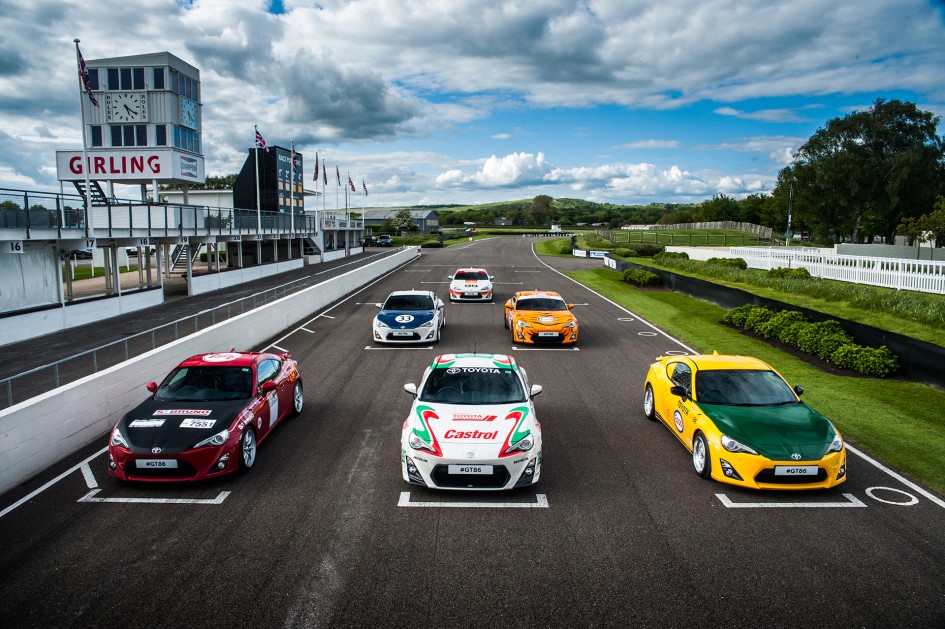Partager la publication "Toyota GT86 à l’honneur au Festival of Speed: six classic liveries ハチロク Road to Goodwood 2015"
On est en juin. Et en juin, en France, il y a le weekend des 24 Heures du Mans qui approche ! Et fin juin, en Angleterre, il y a le Festival of Speed de Goodwood, du 25 au 28 juin prochain ! Autant dire que le mois de juin est savoureux ! Outre un programme riche comme chaque année, Goodwood accueillera quelques Toyota GT86 reconnaissable tant par leur livrée que leur histoire ! Toyota présente six GT86 de livrée légendaire. Découvrons en détail autant le véhicule, la Toyota GT86, de la conception à la motorisation, puis ces périodes historiques qui rendent hommage aux quelques disciplines du sport automobile et à l’histoire de Toyota Racing Development.
// I write this post with a mix of french and english in all the text. The major text is write in english, with the high-quality pictures with a French and English caption //
Toyota GT86 / ae86
La Toyota GT86 est un coupé sportif produit par Toyota à partir de 2012. Elle est construite en collaboration avec Subaru, chez qui ce modèle se nomme BRZ. Ce coupé, dont le nom est un hommage à la Toyota ae86 (modèle Sprinter Trueno et Levin), et est issue du concept-car FT-86.La forte demande pour un retour de l’AE86 a été entendu par Toyota puisqu’un coupé sport propulsé, sur base de moteur Subaru Boxer est sorti en 2012 avec la Toyota GT86. Elle se nomme Toyota 86 au Japon et en Australie et est prend le nom de Scion FR-S pour le marché nord-américain.
En complément lire : Subaru BRZ STI Perf’ Concept, Boxer de Super GT : 300bhp to 450bhp / 304 ch à 456 ch #NYIAS (EN/FR)
Le moteur de la Toyota GT86
La Toyota GT86 fait partie des rares sportives à être encore équipée d’un moteur atmosphérique, ceci afin de conserver la sportivité propre à ce type de motorisation, à savoir sonorité évocatrice, du caractère haut dans les tours et surtout un temps de réponse moteur quasi-instantané.
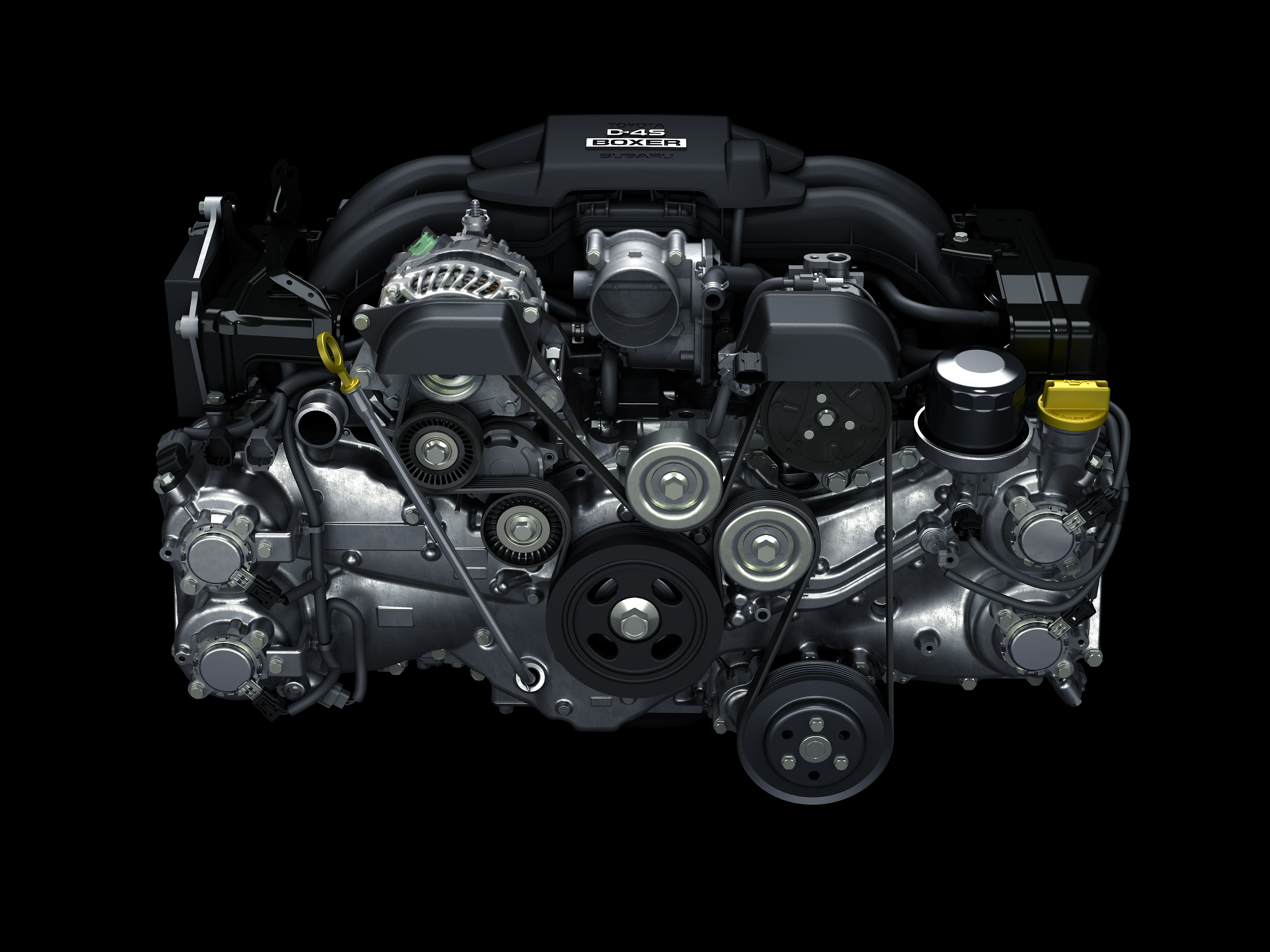
Toyota GT86 – Subaru – engine / moteur
On retrouve ici un quatre cylindres à plat opposés de 1 998 cm3. Ce moteur atmosphérique délivre son couple maximum, soit 205 Nm, de 6400 à 6600 tr/min et ses 200 ch à 7000 tr/min. Ces régimes élevés dénotent le caractère pointu du moteur, délivrant ainsi 100 ch au litre.
Avant d’aller découvrir les livrées présentes à Festival of Speed Goodwood 2015, regardons, voire admirons la Toyota GT86 Carbon Edition, présenté en début d’année 2015.
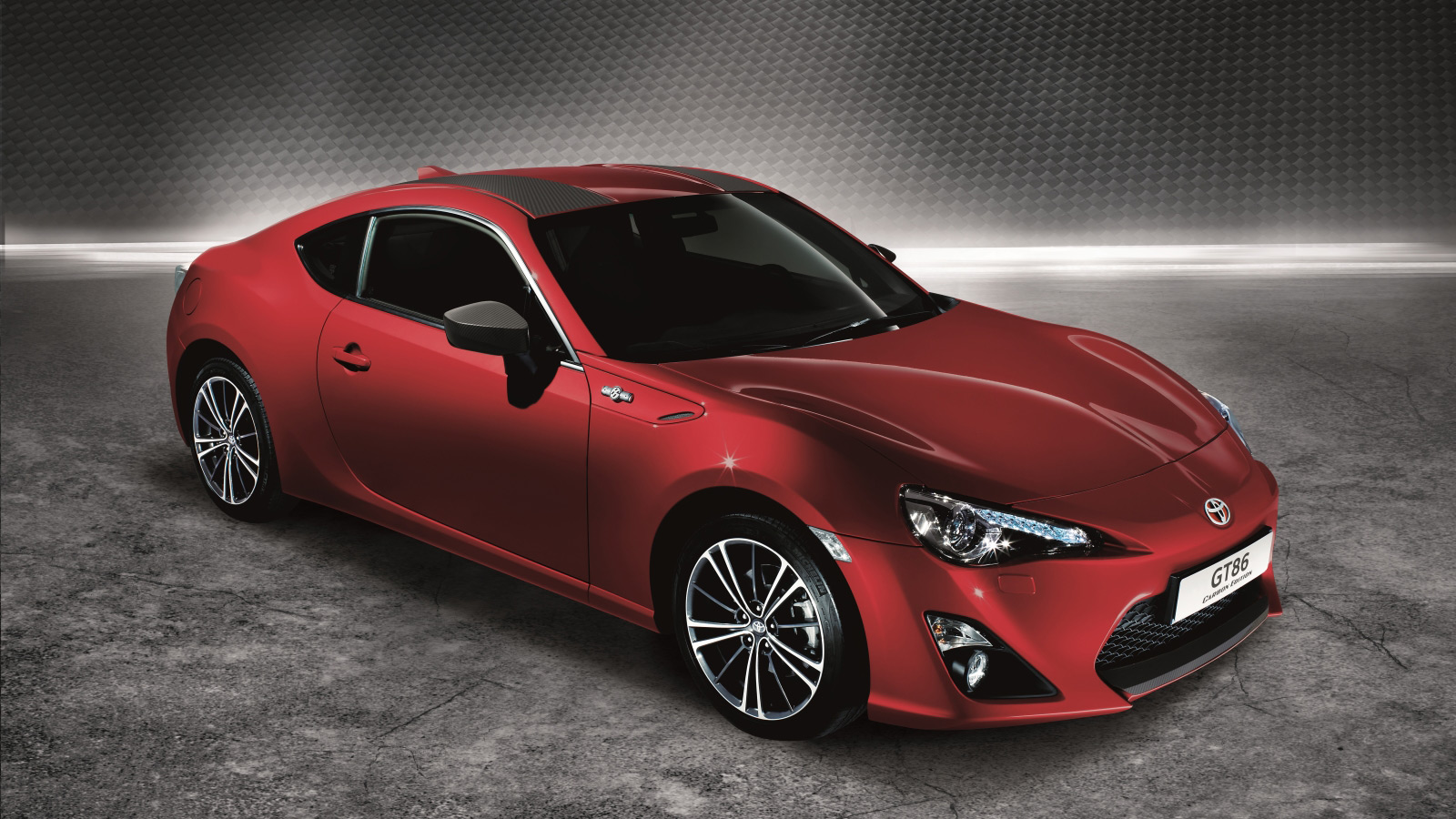
Toyota GT86 Carbon Edition
Toyota GT86 / eight-six / ハチロク
The 86 is a series of grand tourer sports coupés jointly developed by Toyota and Subaru and solely manufactured by the latter. It features a boxer engine, front-engine, rear-wheel-drive layout and 2+2 seating.
The names
Toyota 86 / GT86 / FT86 / Subaru BRZ / Scion FR-S
It is sold worldwide under three different brands with respective model names: Toyota 86 in Asia, South Africa, South America and Australia; GT86 in Europe; both of the preceding names in New Zealand; FT86 in Jamaica; Subaru BRZ worldwide; Scion FR-S in the US and Canada.
The name
The development code of this vehicle is 086A and its main production names 86 (pronounced « eight-six » or Hachi-Roku (ハチロク) in Japanese, but more commonly pronounced as « eighty-six ») or GT86, leverage historic Toyota front engined and rear-wheel drive sports coupés and hatchbacks, in the form of: the 1967 2000GT (Japan’s seminal coupé whose design cues adorn the 86 and which was also powered by a 2.0 litre engine); and the 1983 to 1987 AE86 range (renowned for its handling and drifting prowess). The project also leverages Toyota’s first sports car, the Sports 800, for its shared boxer engine layout.
Toyota FT-86: the concept of GT86
Initial layout and design elements for the 86 were first presented via the Toyota FT-HS concept car at the Detroit Motor Show in 2007. The FT-HS had a front engine, rear-wheel drive layout and 2+2 seating, but utilized a V6 engine with hybrid electric assistance. In 2008 Toyota bought 16.5% of Fuji Heavy Industries, parent to Subaru. Toyota, led by project leader Tetsuya Tada, offered Subaru involvement in their sport coupé project, co-developing a new boxer engine known as the D-4S, but Subaru rejected plans for further development of a rear wheel drive sports coupe due to their vehicle line-up predominantly offering all-wheel drive. Subaru’s balk led the project to a six-month halt before Toyota invited journalists and Subaru engineers to test a developmental prototype to demonstrate the capabilities of the platform. Following the test, Subaru agreed to become further involved in development.
Toyota and Subaru team up
In 2011, Toyota and Subaru unveiled five near-production concept cars to show their progress with the project. The first, known as the FT-86 II Concept, was unveiled at the Geneva Motor Show in March 2011. The team refined the design of the initial FT-86, developing new front and rear fascias, and increasing the dimensions of the car by several millimeters. At the same show Subaru unveiled a transparent silhouette concept car to show off the new D-4S boxer engine and display the ‘Boxer Sports Car Architecture’.
Scion followed next in April at the New York Motor Show with the FR-S Sports Coupe Concept, co-developed with aftermarket tuner Five Axis. Another semi-transparent Subaru, known as the BRZ Prologue, was shown at the Frankfurt Motor Show in September, followed in November at the Los Angeles Motor Show by the BRZ Concept STi, the first full mock-up of Subaru’s version of the 86 with input from Subaru Tecnica International (STi).
Read more: Subaru BRZ STI Perf’ Concept, Boxer de Super GT : 300bhp to 450bhp / 304 ch à 456 ch #NYIAS (EN/FR)
The 86 was designed around a front-mounted boxer engine, rear-wheel drive configuration, inspired by the AE86. The flat architecture of the boxer engine allows it to be mounted low, dropping the center of gravity down, resulting in sporty handling characteristics. The exterior design of the 86 was inspired by the Toyota 2000GT’s extremely low-to-the-ground profile and long, sleek hood. Its design cues translate onto the 86 in such areas as: upward trailing edge of the doors; the upward finish to the side-window line; the front and rear haunches; the circular taillights set in silver (singular instead of double as on the 2000GT).
“The goal was to create an authentic rear-wheel drive sports car with compelling style, exceptionally balanced performance and handling, flexible utility and surprising MPG.” - the 86’s designers, Toyota
The 86 ‘boxer’ side badge appears on all Toyota and Scion versions of the car, but not the Subaru BRZ. Aside from badging, the main differences between the 86/GT86 and the BRZ are the front grilles and bumper bars. The rest, including the 17 inch alloy wheels, are shared.
“There is definitely going to be a more TRD oriented variant down the line. However any of the parts that would be standard on the TRD model will fit on your current Toyota 86 so there is no need to wait.” - Mr. Tada, the lead engineer, Toyota
The 86’s engine, known by the Toyota code 4U-GSE and Subaru code FA20, is a naturally aspirated four-cylinder engine that uses Subaru’s horizontally opposed boxer engine layout that runs on 98 RON (premium unleaded) fuel. Toyota added their D-4S injection system which uses both direct and port injection. The engine has a 12.5:1 compression ratio and a bore and stroke of 86 mm (3.4 in) that results in 200 horsepower (149 kW; 203 PS) at 7,000 rpm and 151 lb·ft (205 N·m) of torque at 6,000 rpm.
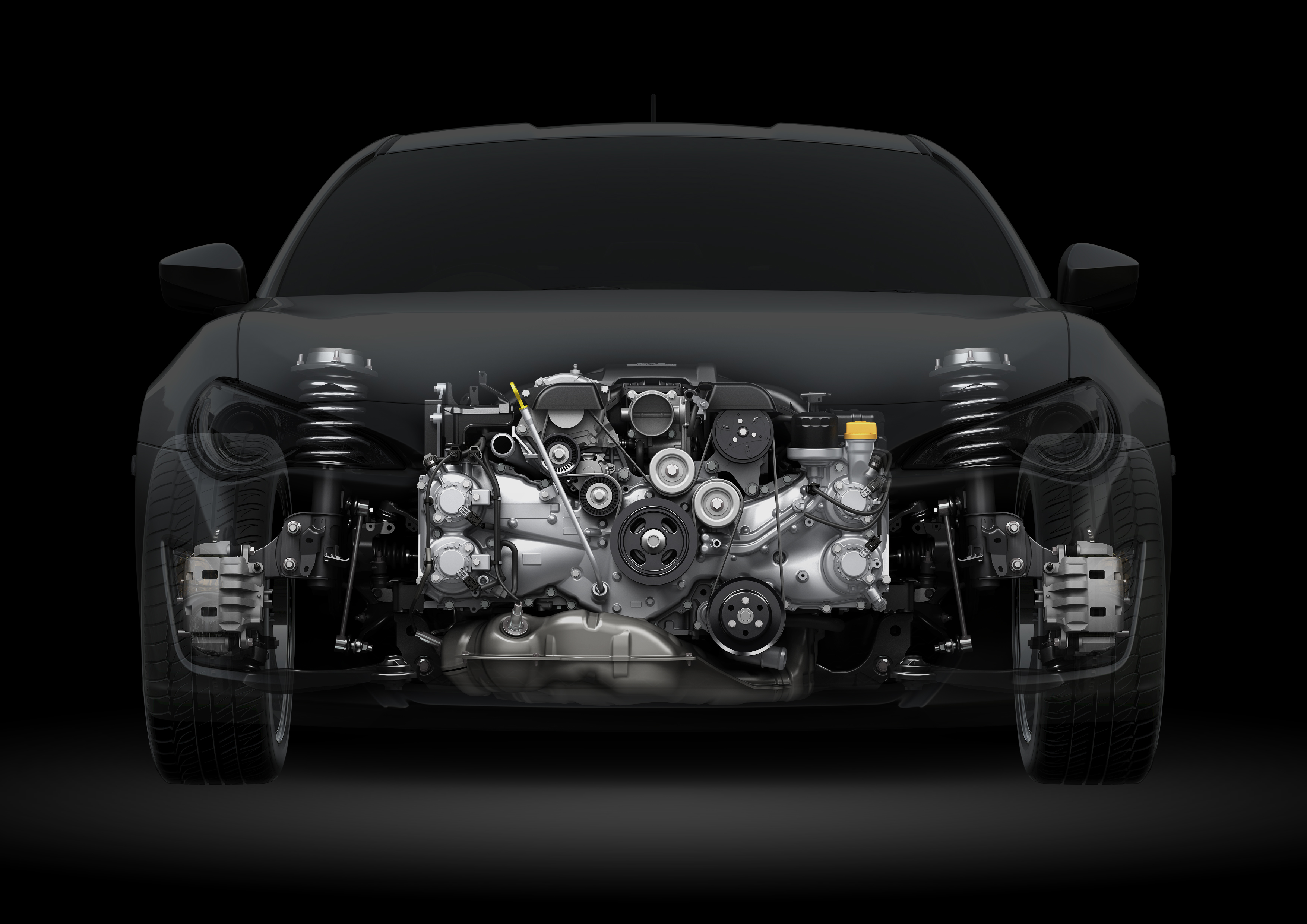
Toyota GT86 – front / avant – engine / moteur
As part of the 86’s low-weight design, the car utilizes an aluminium hood, a solid roof, and a trunk as opposed to a hatchback. The boxer engine sits as far back and as low as possible in the engine bay for a weight distribution of 53% in front and 47% in the rear.
The 86, BRZ and FR-S are offered with two 6-speed transmissions, an in-house developed Toyota TL70 manual gearbox (based on Aisin AI’s AZ6) and an Aisin-Warner A960E, which is modified from that used on the Lexus IS 250. The automatic uses a traditional wet torque converter design, but its software has been engineered to mimic the response of a dual-clutch gearbox. The automatic transmission uses three different modes: Sport, Snow, and Normal. A torque sensing limited slip differential is standard on most models.
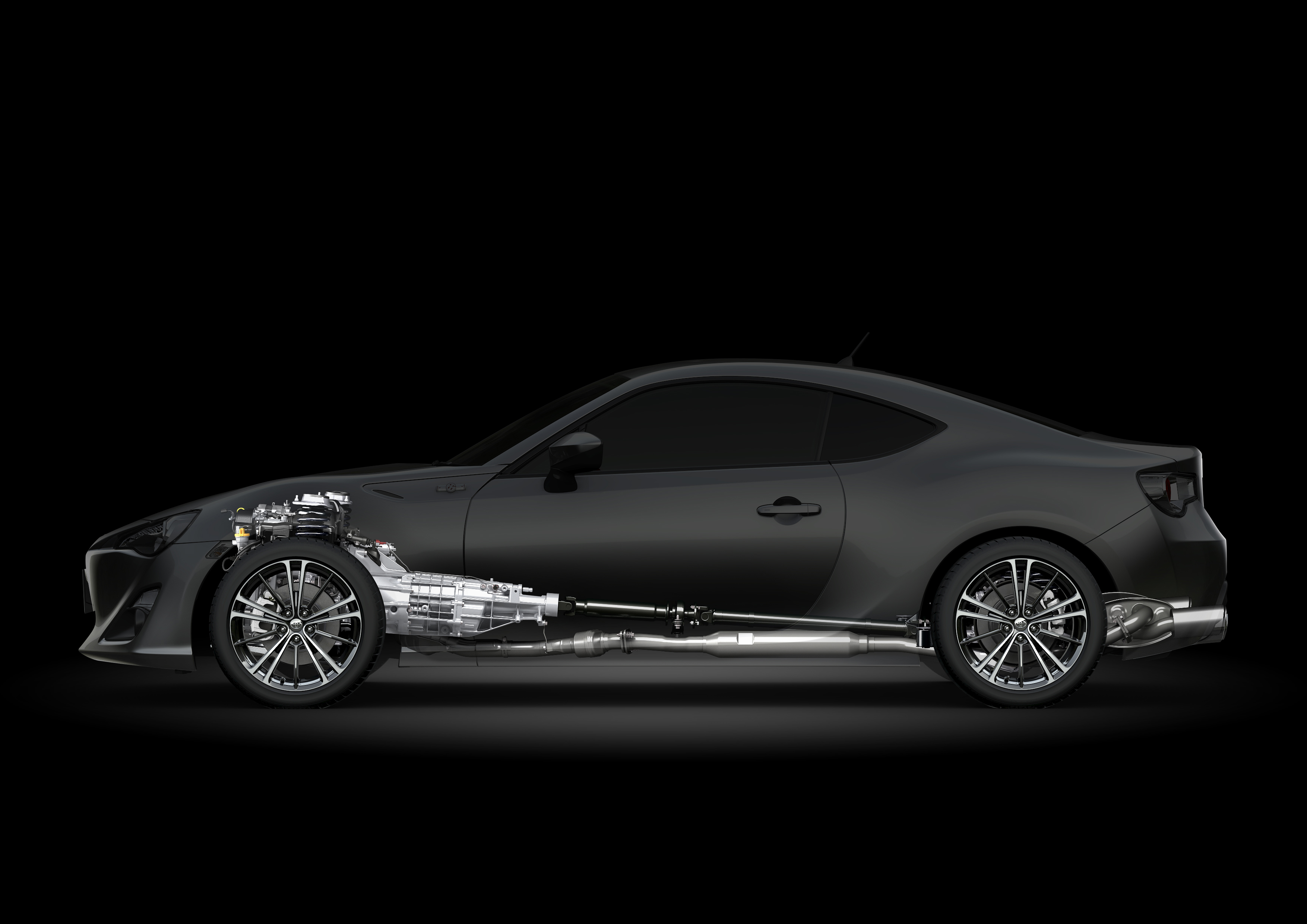
Toyota GT86 – side-face / profil – mechanical / mécanique
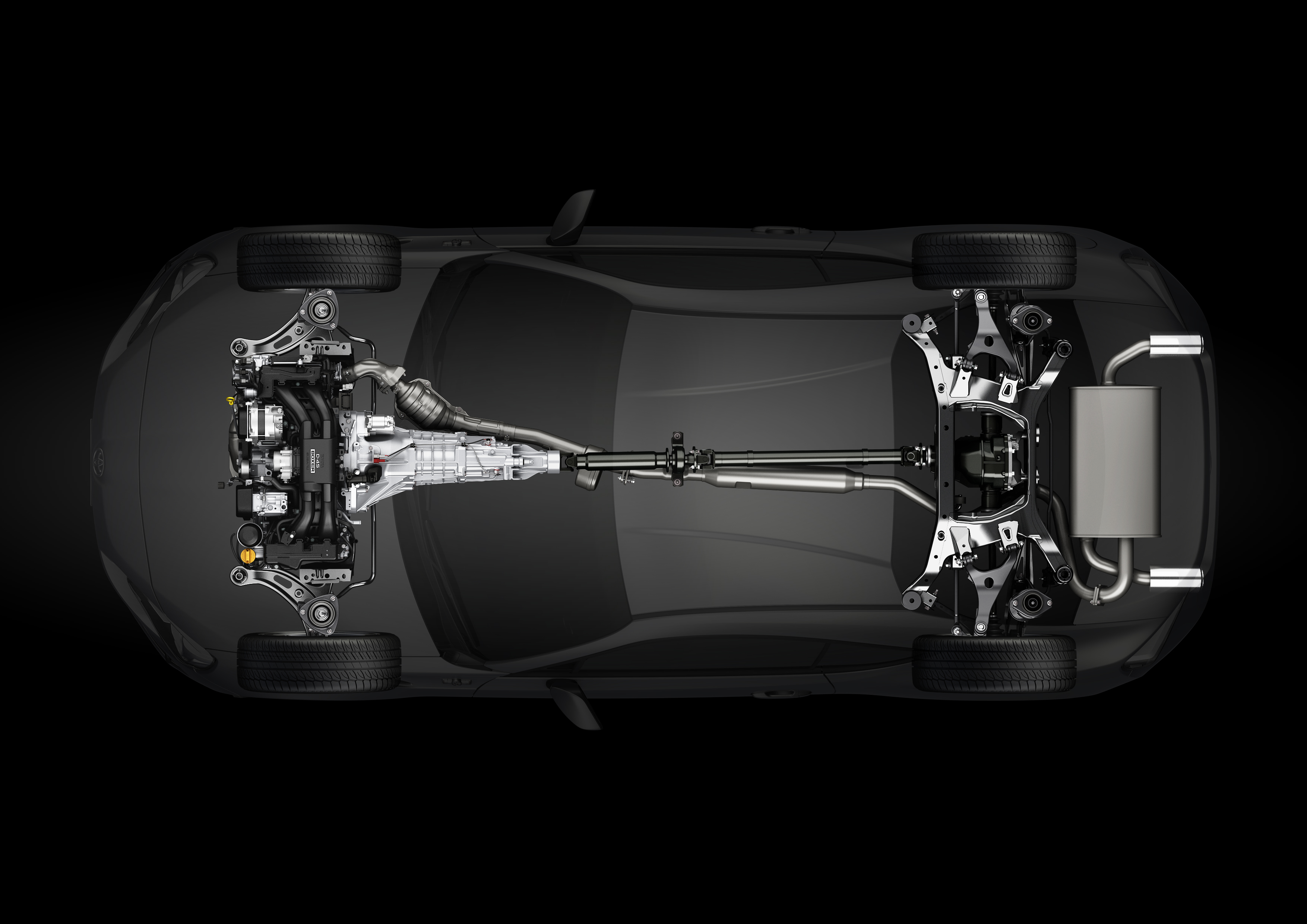
Toyota GT86 – top / haut – mechanical / mécanique
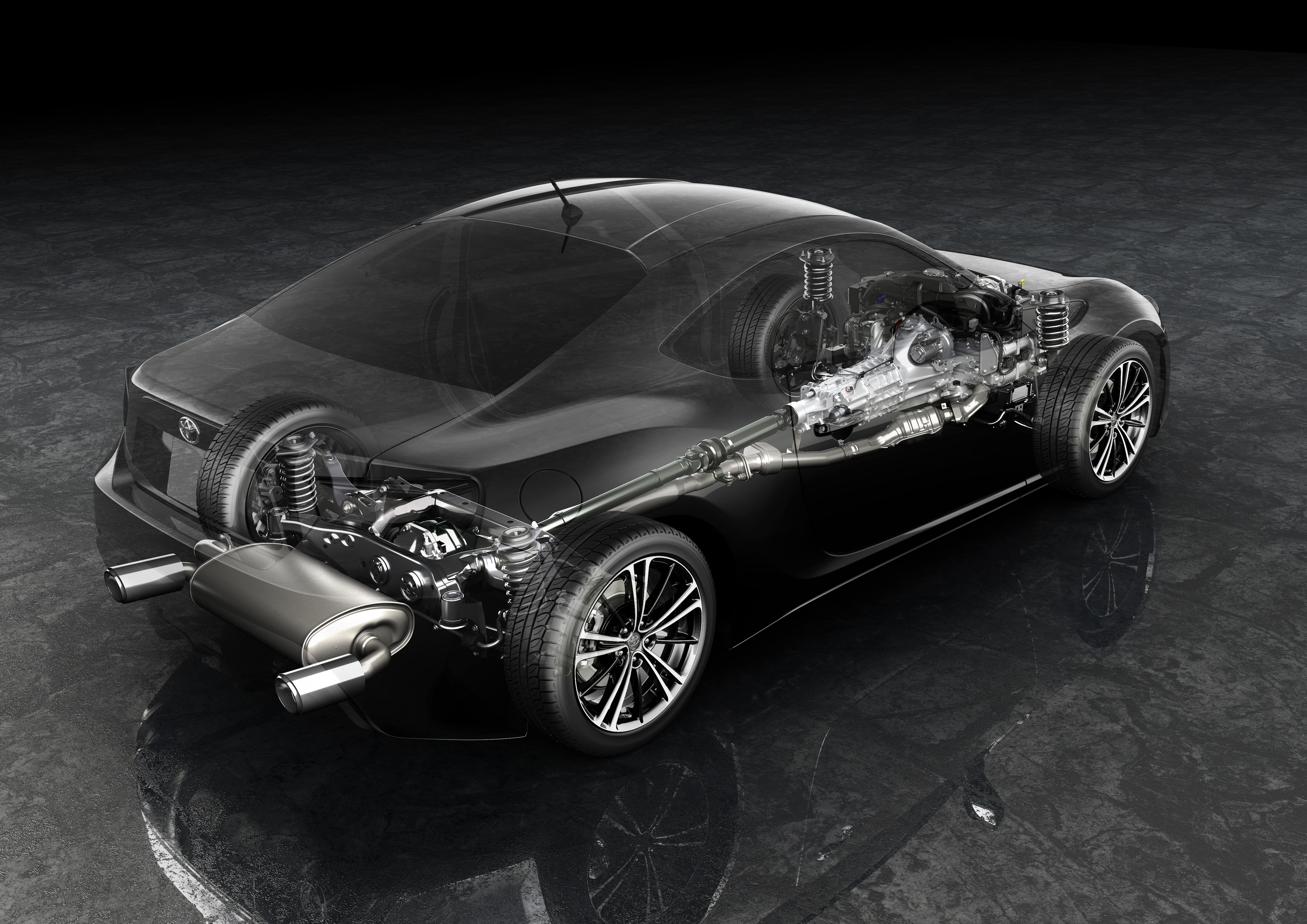
Toyota GT86 – rear / arrière – mechanical / mécanique
Toyota Racing Development
TRD was created out of two Toyota vehicle preparation companies: Toyopet Maintenance Company Ltd (founded in 1954) and Toyopet Service Centre Company Ltd, or TOSCO (which succeeded the first entity in 1964).
Toyota Racing Development, or TRD, is Toyota’s in-house motorsport preparation and road car tuning department. It was officially established in 1976 but its roots can be traced back another 19 years to Toyota’s landmark entry into the world of competitive motorsport. This in-depth review helps to tell its story.
Toyota pour FoS 2015, Goodwood
Toyota s’est inspiré des livrées d’époque de six modèles sportifs différents et de les transposer sur la GT86 : Toyota 2000GT de 1966 à 1970, Celica 1600GT rallye 1972 de Ove Andersson, Celica IMSA GTU de 1980, Celica GT-Four WRC de 1994/1995 et Supra All Japan GTCC Esso Ultron Tiger de 1995 à 2006.
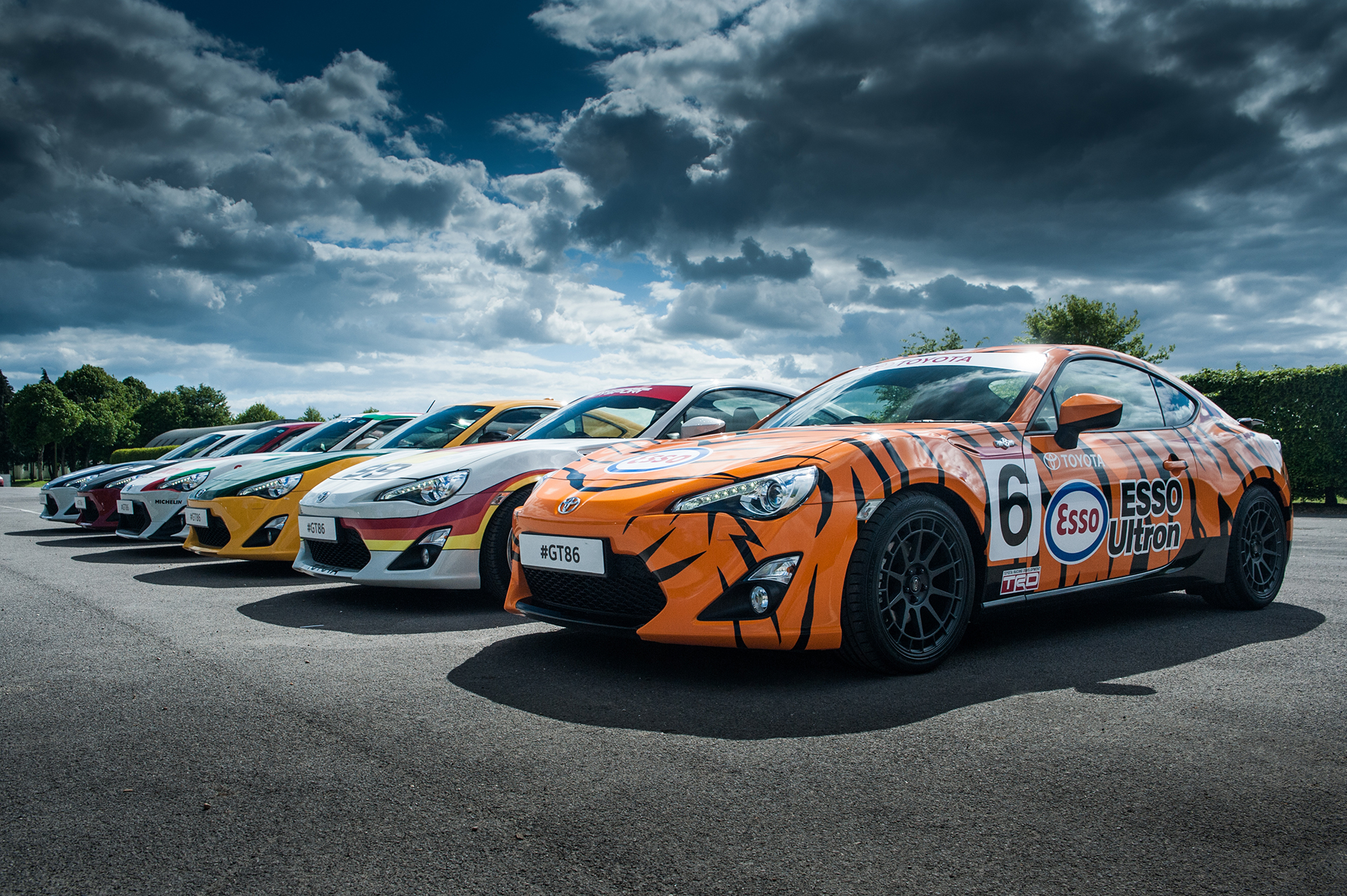
Toyota GT86 – classic livery – FoS 2015 – arrière / rear
Toyota GT86 pays tribute to its heritage with classic liveries
Many of the qualities that make the Toyota GT86 an exceptional modern sports car are rooted in generations of classic performance Toyotas, from its great handling to its timeless, low-slung styling. In a tribute to some of the great race and rally cars of the past 50 years, a fleet of six GT86 has been transformed with faithfully recreated classic liveries and retro styling details.
Each car is inspired by a different model. They include two sporting versions of Toyota’s original sports car, the 2000GT, and Ove Andersson’s 1970s Celica 1600GT rally car – the machine that helped inspire Toyota to launch a full international motorsports programme. The IMSA GTU Celica that raced in North America in the 1980s, the World Rally Championship Celica GT-Four and the Esso Ultron Tiger Supra from the All-Japan Grand Touring Car Championship are also celebrated.
Toyota GT86 making-of six replicas
Vehicle vinyl specialist Motor Mode has reproduced key elements from the original liveries in the right proportions for the GT86. New springs bring the cars’ ride height down by 40mm and Rota has provided new wheels in different finishes to capture the retro look. A new Milltek Sport stainless steel exhaust system provides the finishing visual and aural flourish.
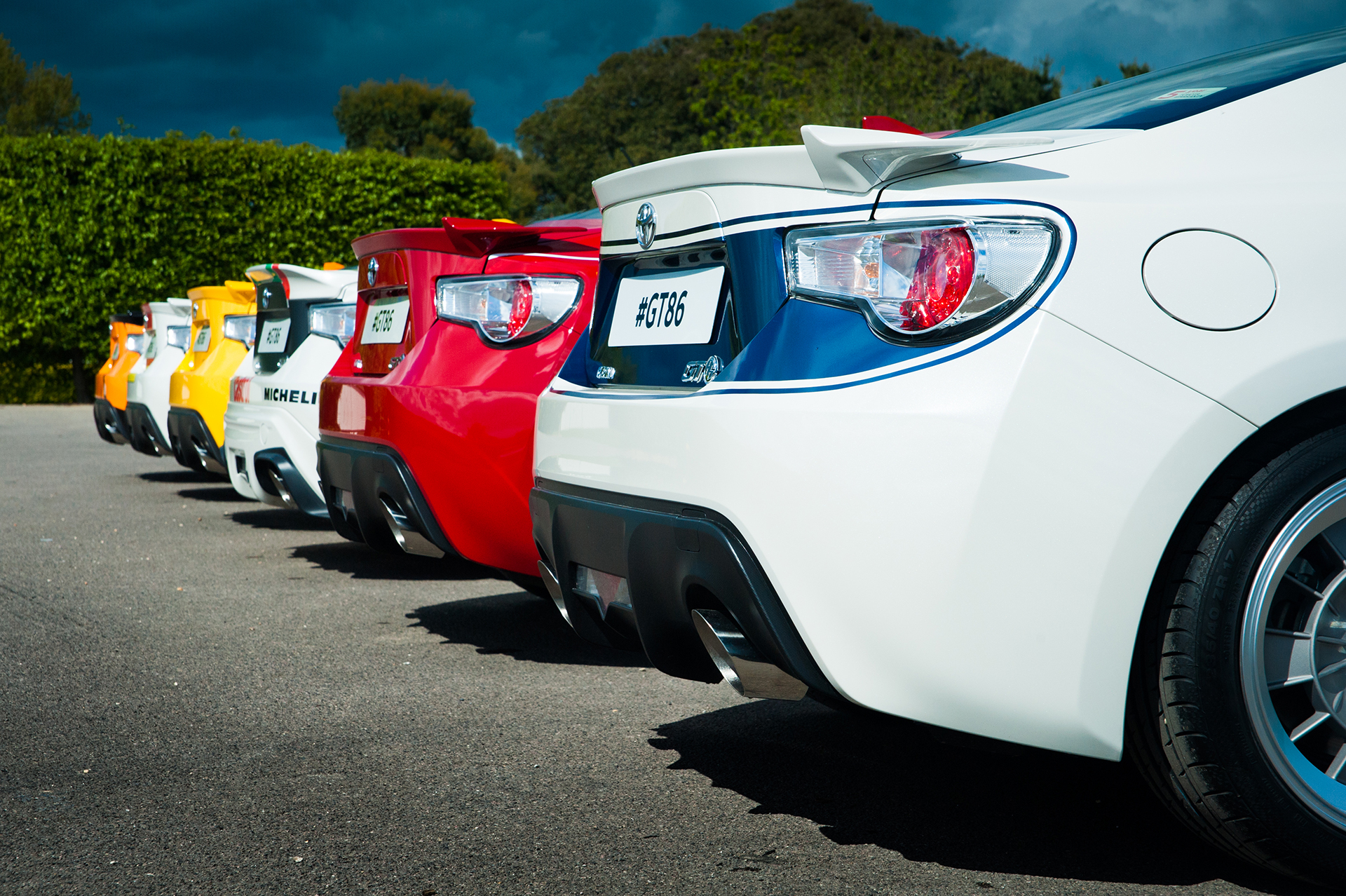
Toyota GT86 – classic livery – FoS 2015 – arrière / rear
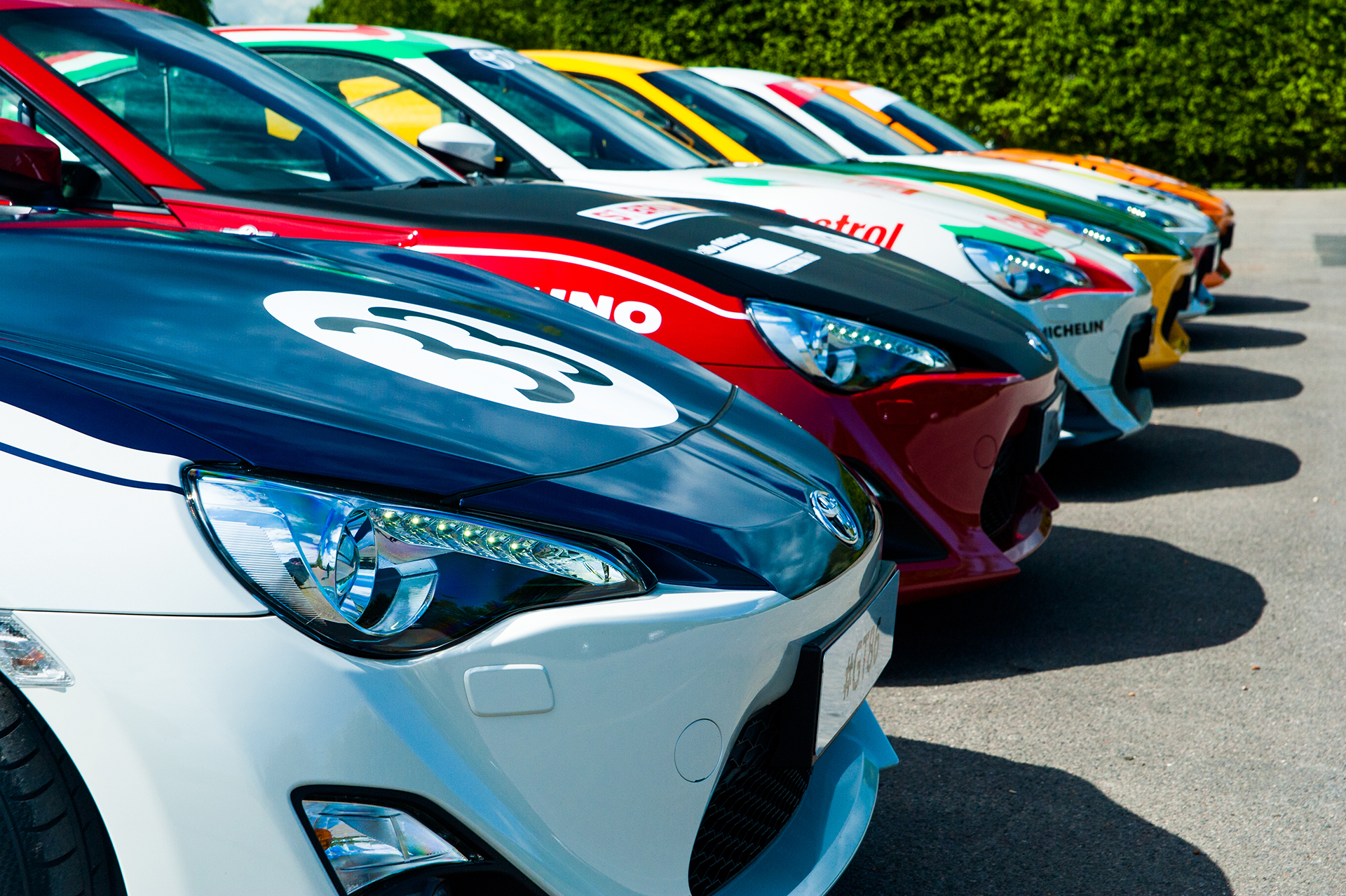
Toyota GT86 – classic livery – FoS 2015 – avant / front
The coupes – a strictly one-off collection – are making their debut at the Goodwood Festival of Speed’s Moving Motor Show on 25 June where they will be available for public test drives on a first come, first served basis. For the remainder of the festival they will be on static display at the Goodwood racing circuit, supporting the hugely popular GT86 Drift Experience.
Toyota’s presence at the 2015 Goodwood Moving Motor Show is a tantalising mix of old and new – a sextuplet of the latest Toyota GT86 coupes modified to resemble key cars from our illustrious motorsport heritage.
“Each of the six Toyota GT86 models featured visually arresting livery created and applied by the vinyl graphic specialists at Motor Mode UK. Careful reference was made to archive material to ensure that all the shapes, colours and logos of the original designs were replicated as closely as possible around the GT86 silhouette.”
“Under the skin, we decided that the GT86s should share aftermarket suspension and exhaust components. With regards to the latter, we wanted the cars to sound as evocative as they looked. So we turned to exhaust manufacturer Milltek Sport to supply us with fruity cat-back exhaust systems to replace the standard pipework.”
“We opted to fit progressive rate V-Maxx lowering springs designed to work alongside the original dampers. Two versions are available for the GT86, offering either a 30 or 40mm suspension drop on both axles. We chose the lower option.”
“Supplied by The Performance Company, V-Maxx Sportsprings have a solid reputation within the tuning community, founded on TüV-approved construction and favourable spring rates that strike a favourable balance between sporty handling and ride comfort.”
“Most alloy wheel manufacturers concentrate on contemporary designs, but we knew of one particular manufacturer that has become a mainstay of the aftermarket by dividing its rolling artistry between cutting-edge, retro-inspired and motorsport designs – Rota Wheels. So we challenged UK importer Rare Rims to see if it could source wheels of the right design, size, offset and stud pattern to suit the GT86 and closely match those seen in the archive images we supplied.”
“With new suspension and wheels now installed, the only thing remaining was to restore the geometry to within factory tolerances for straight-line stability and even tyre wear. After this was complete, the cars were then ready for their group photoshoot and for their first public appearances at the 2015 Goodwood Festival of Speed.”
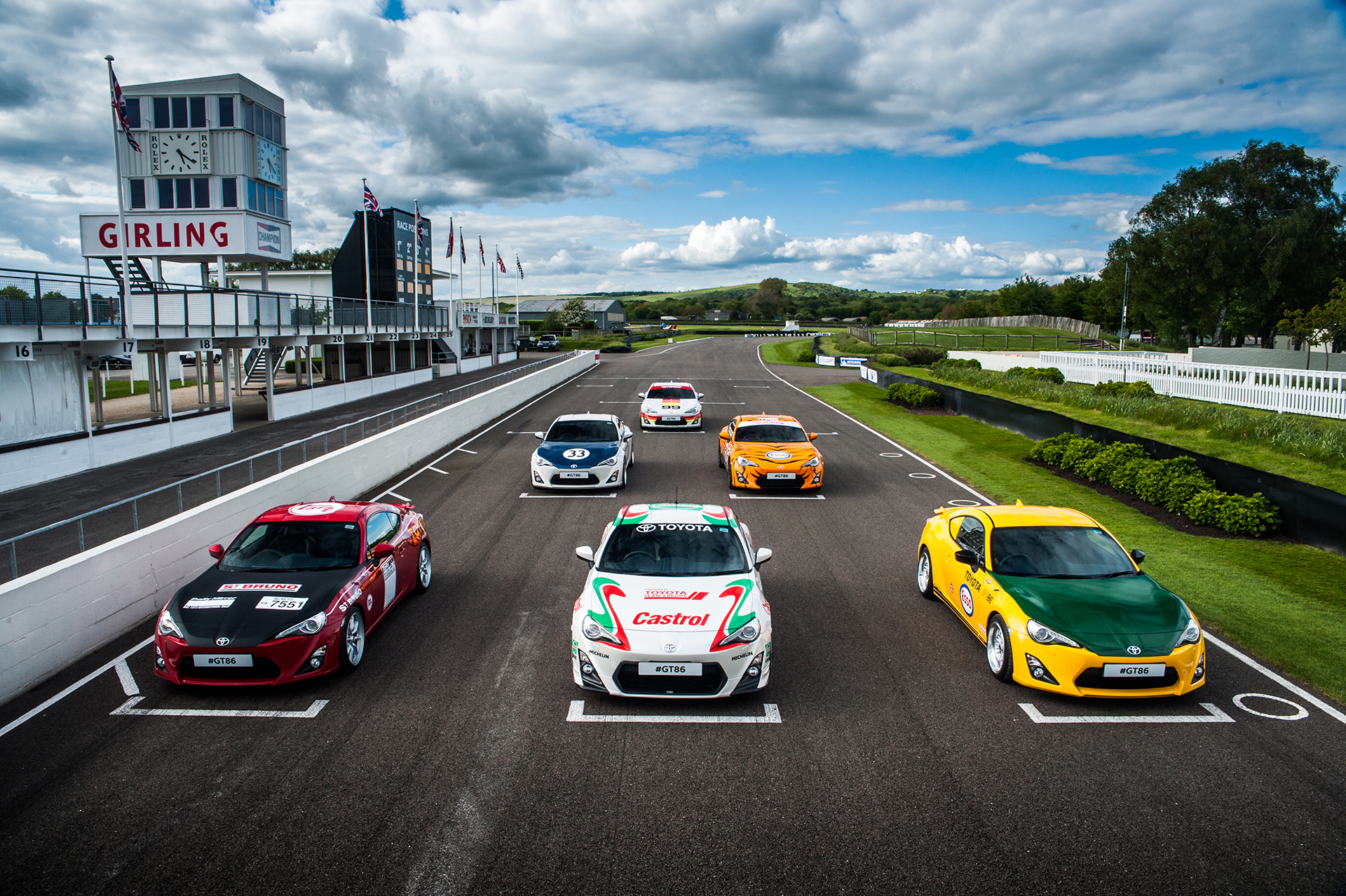
Toyota GT86 – classic livery – FoS 2015 – face avant / front
Toyota GT86 ‘Toyota 2000GT Yatabe Speed Trial’ – Goodwood 2015
Toyota 2000GT Yatabe Speed Trial, livrée jaune avec capot vert : cette 2000GT a obtenu de nombreux records de vitesse et d’endurance internationaux pendant une course de 72 heures au cours d’essais sur le circuit de Yatabe au Japon en 1966, démontrant l’engagement de Toyota pour l’ingénierie en sport automobile.
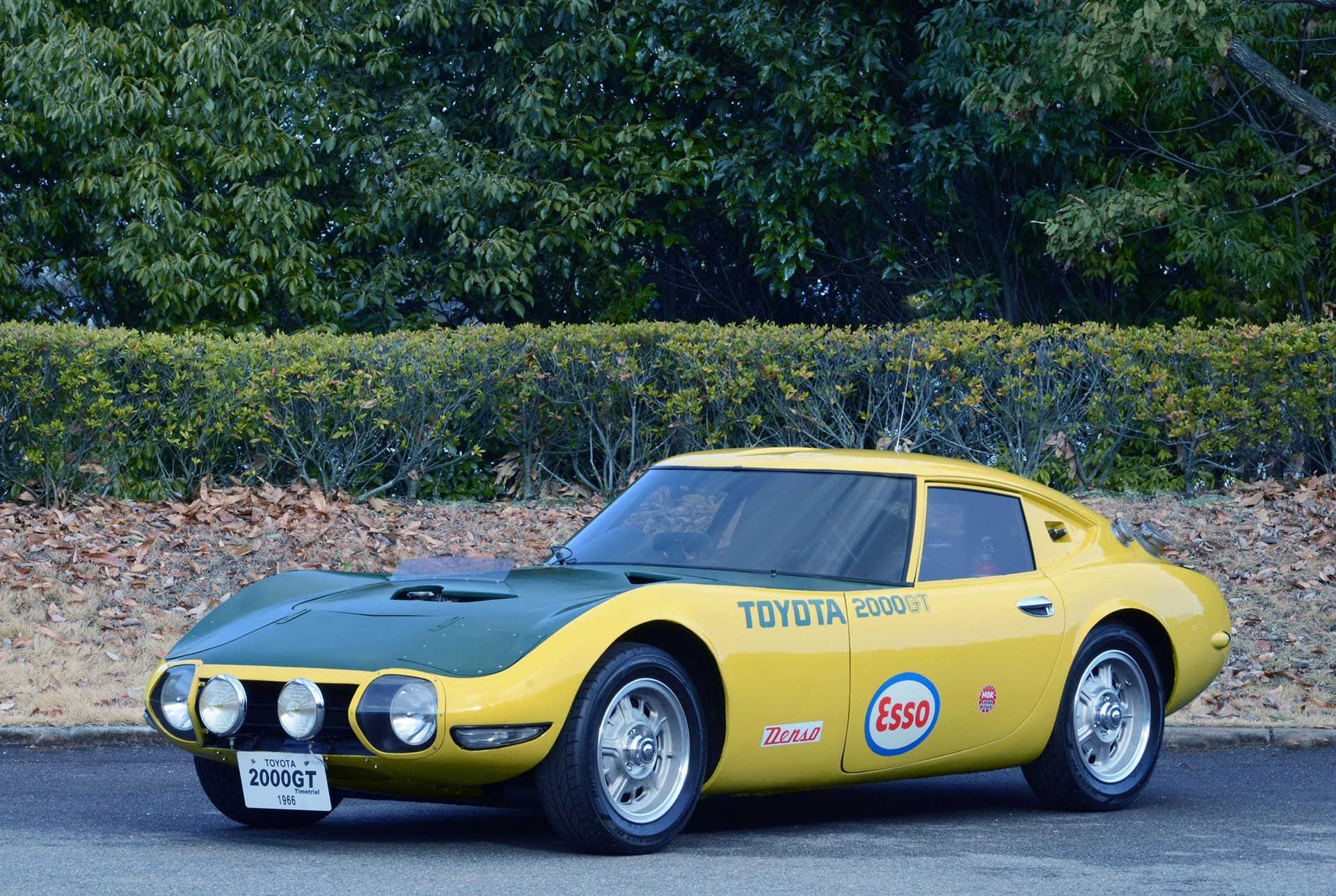
Toyota Yatabe Speed Trial 2000GT
Toyota GT86 inspired by the Yatabe Speed Trial Toyota 2000GT
Yatabe Speed Trial Toyota 2000GT (yellow with green bonnet): this 2000GT set multiple new world and international speed and endurance records during a 72-hour run at the Yatabe High Speed Testing Course in Japan in 1966. It demonstrated Toyota’s commitment to engineering a sports car with world class potential.
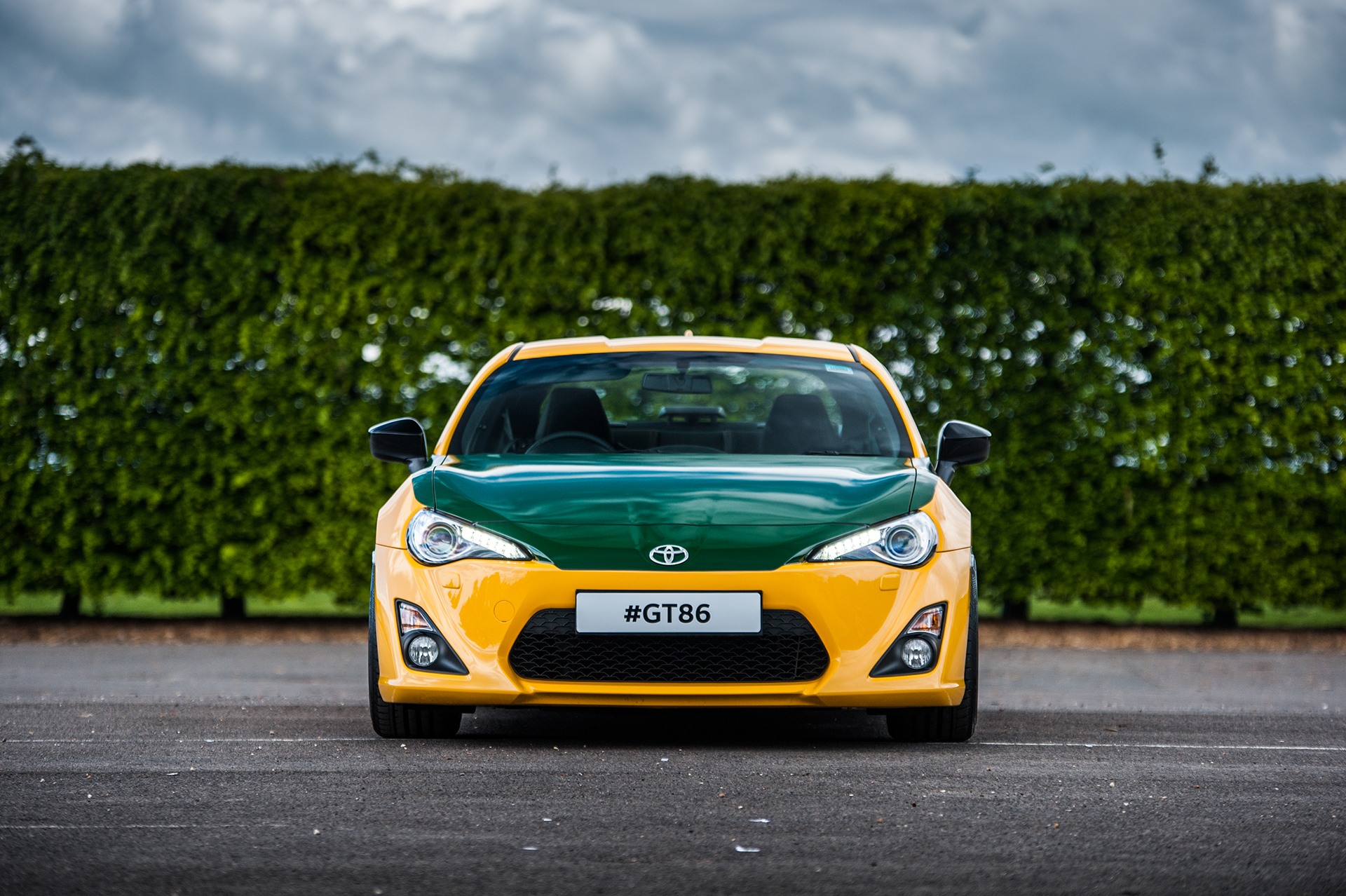
Toyota GT86 – classic-livery – Yatabe Speed Trial 2000GT
After the second Japanese Grand Prix of 1964, Toyota began to develop a range-topping grand touring model in cooperation with Yamaha Motor Co. The 2000GT prototype was unveiled soon afterwards at the 1965 Tokyo Motor Show, followed by the production model’s entry into the domestic market in May 1967.
In order to build anticipation for its commercial release, the car established a reputation on the race track. In May 1966 two lightweight 2000GTs entered the Japanese Grand Prix, one of which came a creditable third place in only its second public appearance. The following month, the same pair entered the Suzuka 1000km endurance race and finished in a resounding one-two formation, hammering home the speed and reliability of this new car.
That fact was underlined in October 1966 when Toyota entered a Tosco (now TRD, for Toyota Racing Development) tuned 2000GT in a Speed Trial held at the Yatabe High Speed Testing Course. By the end of the 72-hour event, the yellow-and-green 2000GT had averaged a pace of 128.76mph around the circuit’s banked oval. During that time it smashed three world records and set 13 new international records for speed and endurance.
The ultra-low coupe body of the Toyota 2000GT was designed in-house and supported by an X-shape backbone frame equipped with a 150bhp 2.0-litre DOHC straight six engine, four-wheel independent suspension and four magnesium alloy wheels. The 2000GT was the first Japanese-made production model to adopt some of these novel components. Its performance was also world-class, including a maximum speed of 136mph and 0-62mph in 8.6 seconds. By the end of production in 1970, a total run of just 351 units had been produced, 337 of which were sold as road cars.
Toyota GT86 ‘Toyota 2000GT Shelby’ – Goodwood 2015
Toyota 2000GT Shelby, livrée blanche avec capot bleu : Carroll Shelby a orchestré le programme de course de Toyota pour la 2000GT aux Etats-Unis. L’intention était de démontrer le potentiel de la voiture lors de compétitions contre la concurrence américaine et européenne. Pilotée par Scooter Patrick et Dave Jordan, cette voiture obtenu un certain nombre de victoires au cours de la saison 1968.
Découvrir l’histoire de Shelby : Shelby rencontre Ford – la légende de la Mustang et du Cobra – Shelby GT350 (FR)
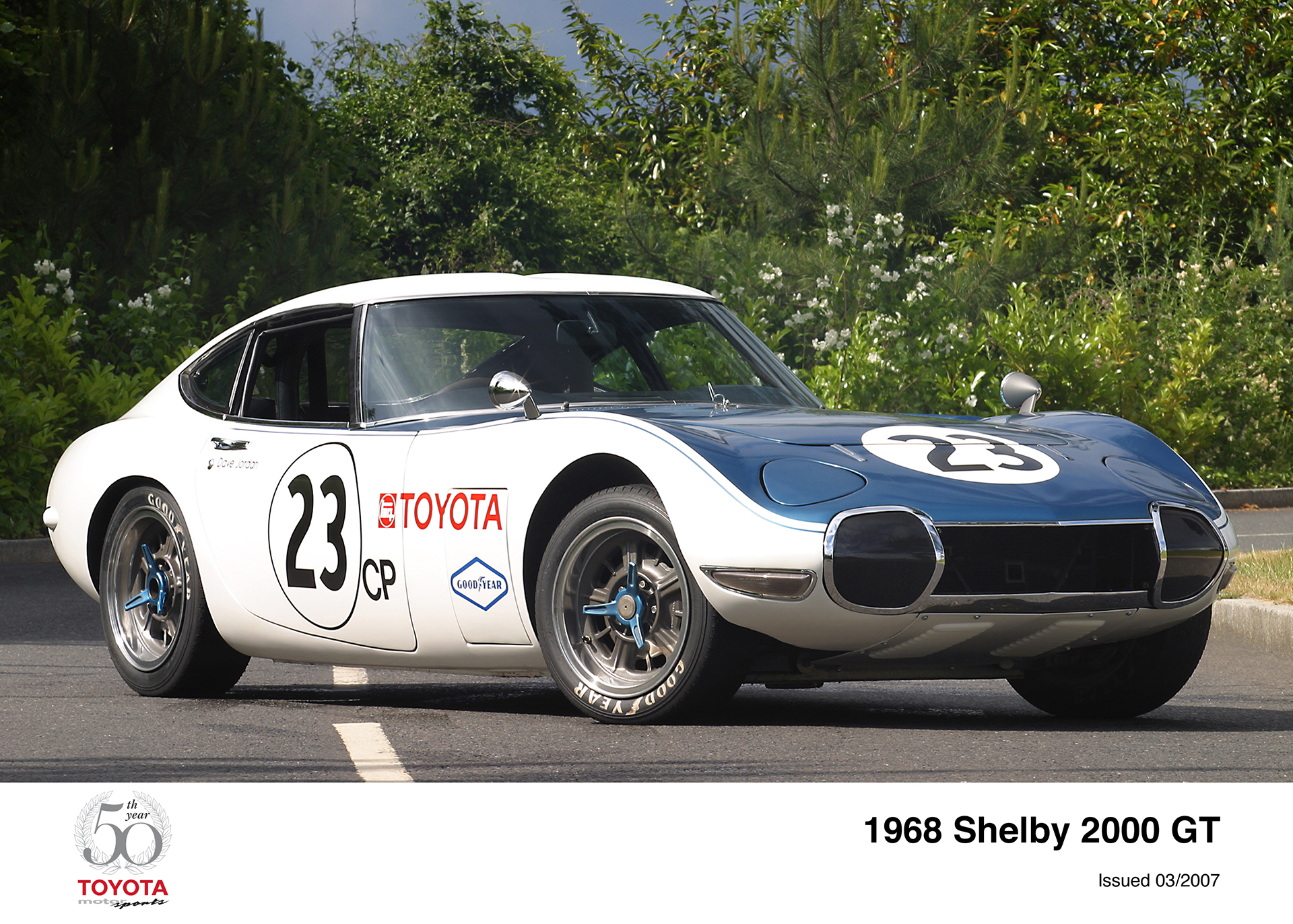
Toyota Shelby 2000GT
Toyota GT86 inspired by the Shelby Toyota 2000GT
Shelby Toyota 2000GT (white with blue bonnet): racing legend Carroll Shelby masterminded Toyota’s racing programme for the 2000GT in the USA. The intention was to demonstrate the car’s potential when pitted on track against established American and European competition. Drivers Scooter Patrick and Dave Jordan duly claimed a number of victories during the 1968 season.
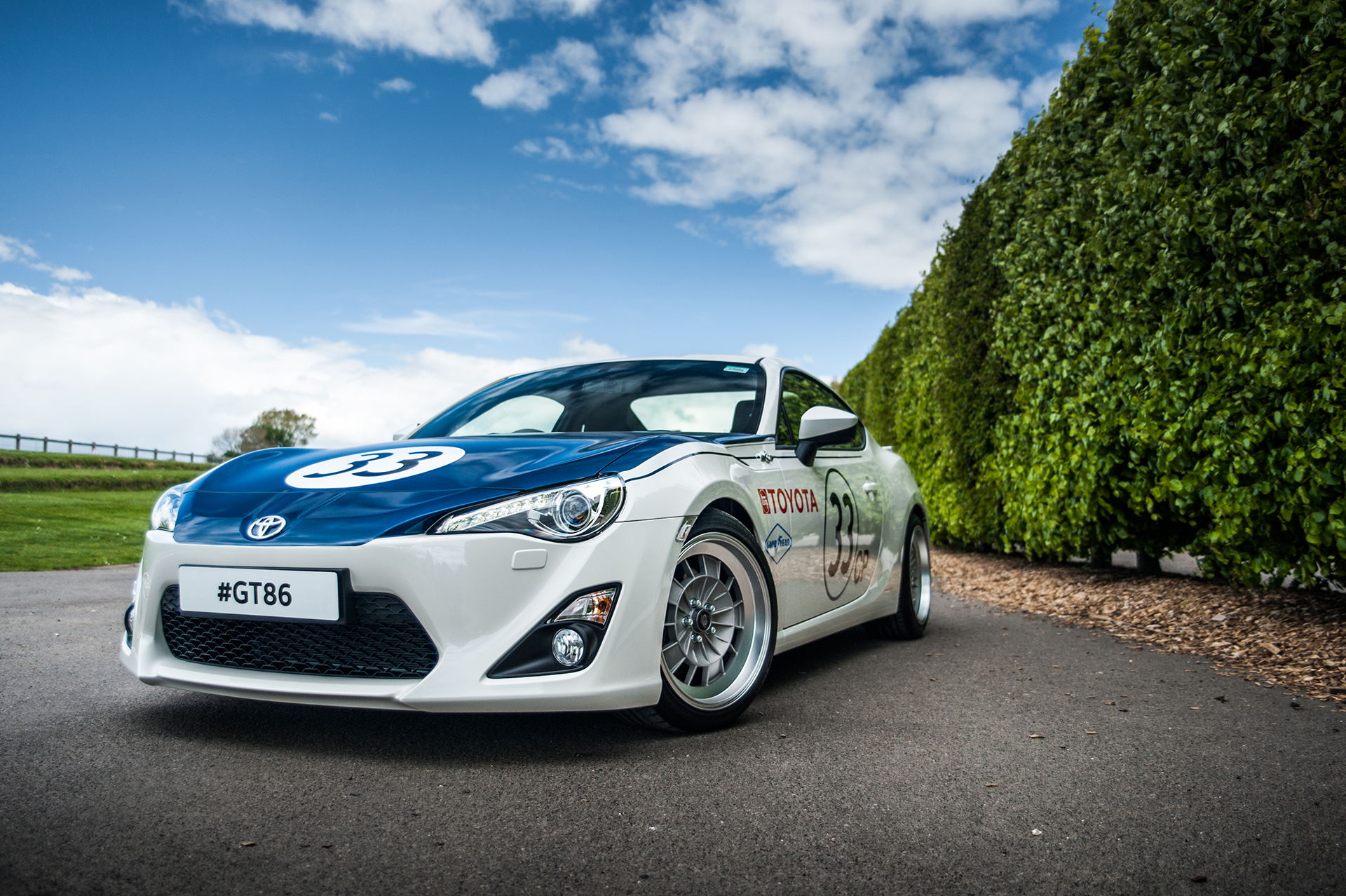
Toyota GT86 – classic-livery – Shelby 2000GT
Encouraged by its success in domestic motorsport, Toyota wanted to demonstrate the abilities of its halo 2000GT model against potential showroom rivals in the crucial North American market. So it was decided that the car should be entered in the production class of the SCCA (Sport Car Association of America) series.
Three cars were handed over to racing legend Carroll Shelby, mastermind behind the high-performance AC Cobra and Ford Mustang. Two cars were destined for the race track, while the third was a spare primarily dedicated for development work.
Shelby’s preparation of the 2000GTs focused on tyres, suspension and a new cylinder head.
The svelte body required little work, though it was stripped of all soundproofing and insulation to reduce weight. Goodyear developed new low-profile tyres for the car, which, in concert with the suspension, brought down the ride height by around six centimetres.
Lowering the car’s centre of gravity delivered benefits in handling along with superior grip from the wider tyres. Road-holding was also improved with the addition of uprated anti-roll bars and Koni coil springs and shock absorbers. The 2.0-litre straight-six engine retained its iron block but was bored-out to receive larger pistons and was fitted with a new aluminium DOHC cylinder head. With such modifications the output rose to around 200bhp. Despite the Toyota delivering less power than its main rival, the Porsche 911, in the hands of Scooter Patrick and Dave Jordan it still recorded a number of race victories during the 1968 championship. A Porsche took the overall title that year but Patrick finished the season in second place and Jordan took third.
Toyota GT86 ‘Toyota Celica 1600GT’ – Goodwood 2015
Toyota Celica 1600GT de Ove Andersson, livrée rouge avec capot noir : c’est automobile qui permis à Toyota de faire son entrée en rallye mondial, ouvrant la voie à la fondation de Toyota Team Europe et finalement à Toyota Motorsport aujourd’hui (qui fera son retour en 2016 en WRC). En 1972, elle fut engagée au RAC Rally* avec le soutien officiel de Toyota. Au mains d’Ove Andersson, elle remporta la victoire de sa classe et se classa à la neuvième place au général.
*Royal Automobile Club, le rallye de Grande-Bretagne (anciennement rallye du Royal Automobile Club, RAC Rally (des origines à 1997).
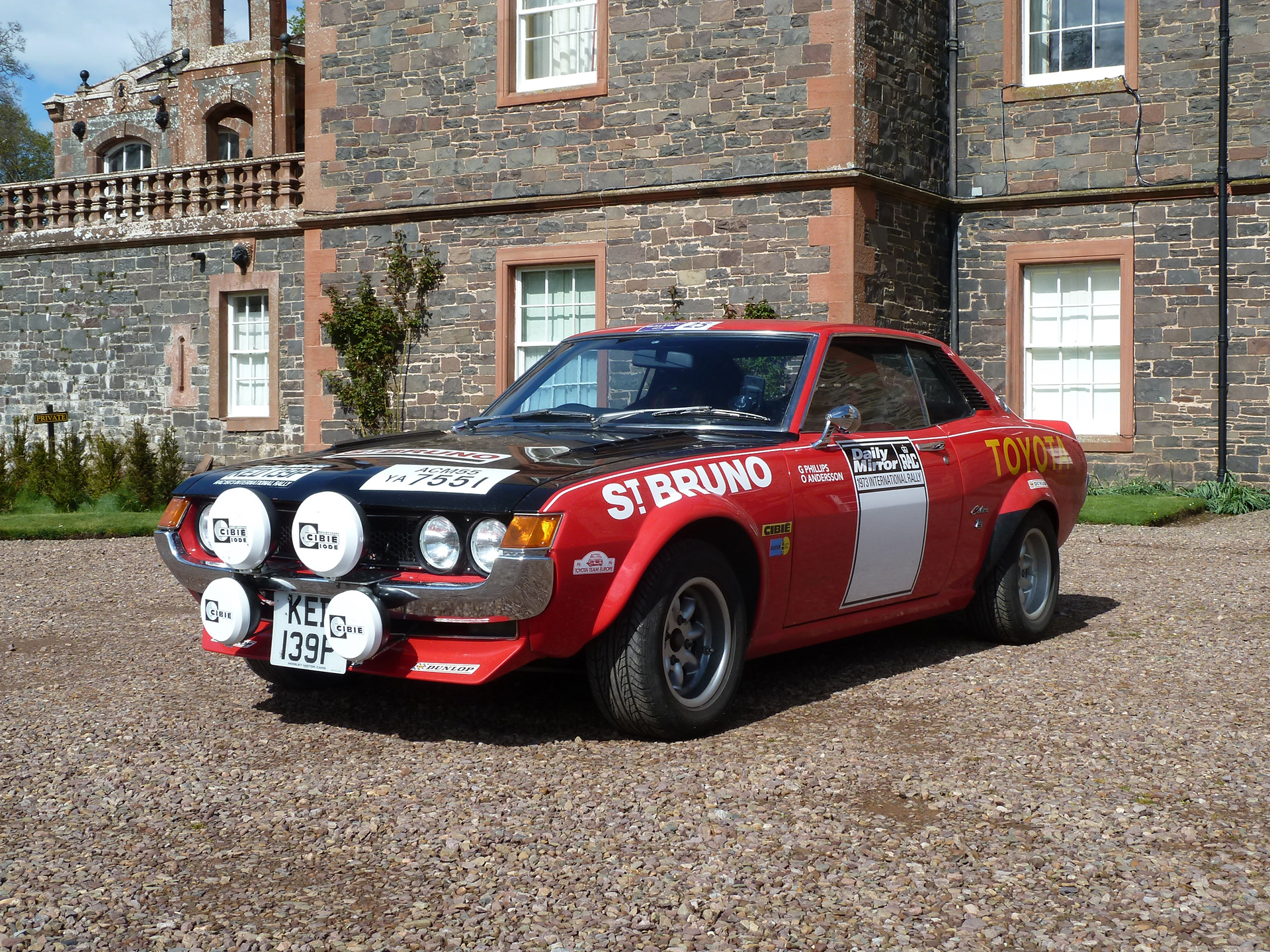
Toyota Ove Andersson Celica 1600GT
Toyota GT86 inspired by Ove Andersson’s Toyota Celica 1600GT
Ove Andersson’s Toyota Celica 1600GT (red with black bonnet): Andersson’s entry in world rallying with the first-generation Celica paved the way for the founding of Toyota Team Europe – and ultimately today’s Toyota Motorsport. The liveried GT86 celebrates the car he entered in the 1972 Daily Mirror RAC Rally, with official manufacturer support from Toyota. His class win and ninth place overall were an early sign of the great things the partnership would deliver.
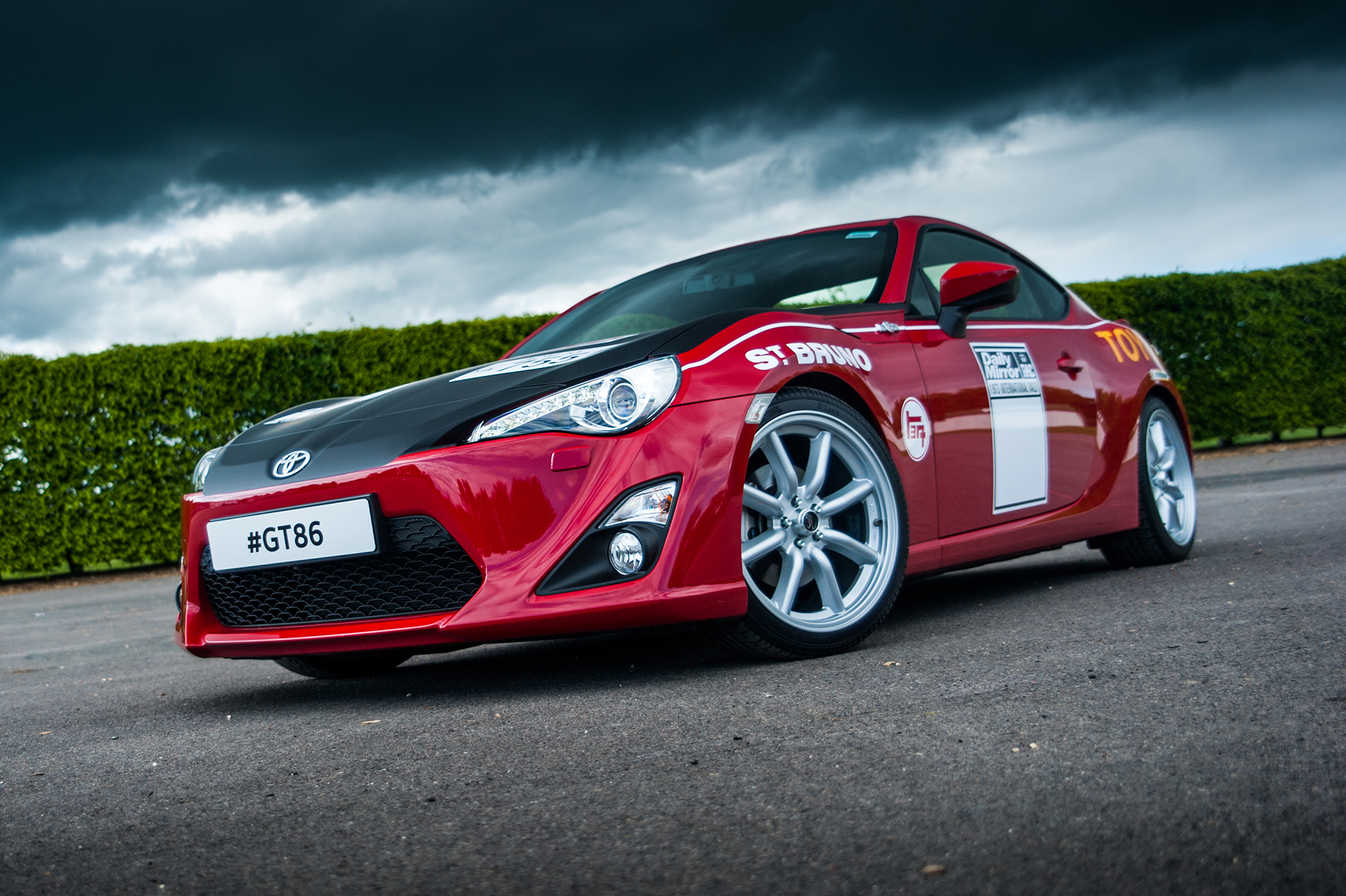
Toyota GT86 – classic-livery – Ove Andersson Celica 1600GT
This relatively unassuming first-generation Toyota Celica has an important place in the history of Toyota in motorsport, being the first manifestation of an official, manufacturer-backed push into world rallying. Its success led directly to the formation of Toyota Team Europe (TTE), which is now known as Toyota Motorsport GmbH (TMG).
The Celica’s arrival in rallying in 1972 came about through a fortuitous meeting between Toyota and leading Swedish rally driver Ove Andersson. Toyota had been looking for a discreet way to enter the World Rally Championship that wouldn’t conflict with the corporation’s stand over the ongoing oil crisis, and Ove was interested in laying the groundwork for a post-retirement business plan in rally car preparation.
A deal was therefore struck in which Ove would be given a car and manufacturer backing in order to prepare a factory fresh Celica for competition in the 1972 Daily Mirror RAC Rally. Immediate success followed, with Andersson and co-pilot Geraint Phillips driving the 135bhp coupe to a class win and ninth position overall – comfortably ahead of the three works Datsun 240Z models.
Buoyed by this result, Toyota helped Andersson establish a more formal works team – Team Toyota Andersson. Initially a relatively low-profile outfit with just four mechanics and run from Andersson’s home in Uppsala, Sweden, the team took on a programme of four major rallies in 1973 using Celicas built to similar specifications. However in February 1975 the team moved to mainland Europe and adopted the official name Toyota Team Europe.
These early Team Toyota Andersson rally Celicas were the only cars in Toyota’s rallying history not to wear the manufacturer’s white base colour livery.
Toyota GT86 ‘Toyota Celica IMSA GTU’ – Goodwood 2015
Toyota Celica IMSA GTU, livrée avec rayures rouges et jaunes : la Celica a été la première Toyota de course à courir en Amérique du Nord sous la bannière du Toyota Racing Developments (TRD) en compétition dans la série IMSA GT. Puis cette Celica IMSA GTU a couru avec le team de Dan Gurney, All-America Racing, entre 1983 et 1985.
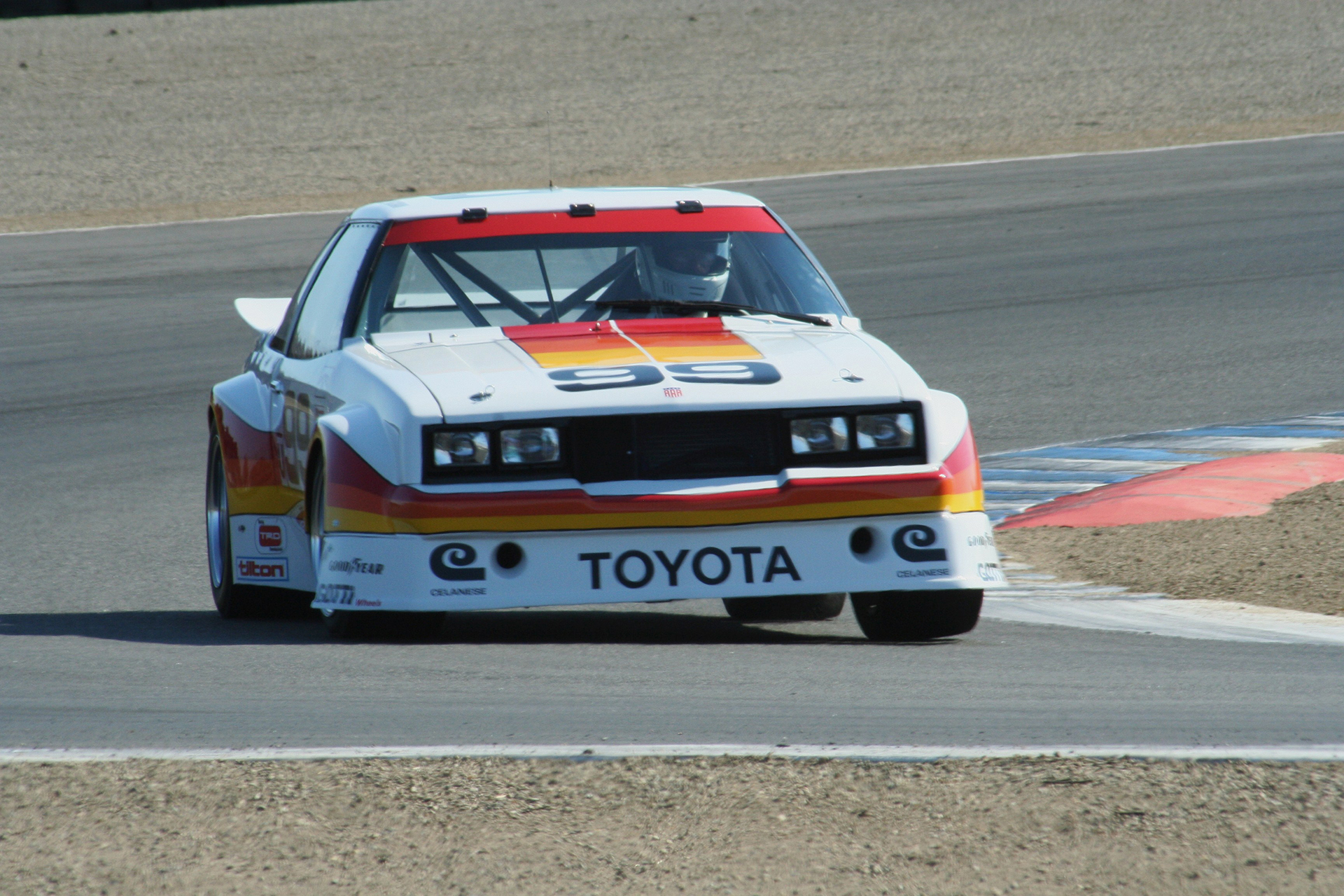
Toyota IMSA GTU class Celica
Toyota GT86 inspired by the IMSA GTU class Toyota Celica
IMSA GTU Toyota Celica (red with yellow stripes): Celica was the first Toyota to race in North America under the Toyota Racing Developments (TRD) banner, competing in the IMSA GT series. The IMSA GTU car prospered with Dan Gurney’s All-America Racing Team between 1983 and 1985.
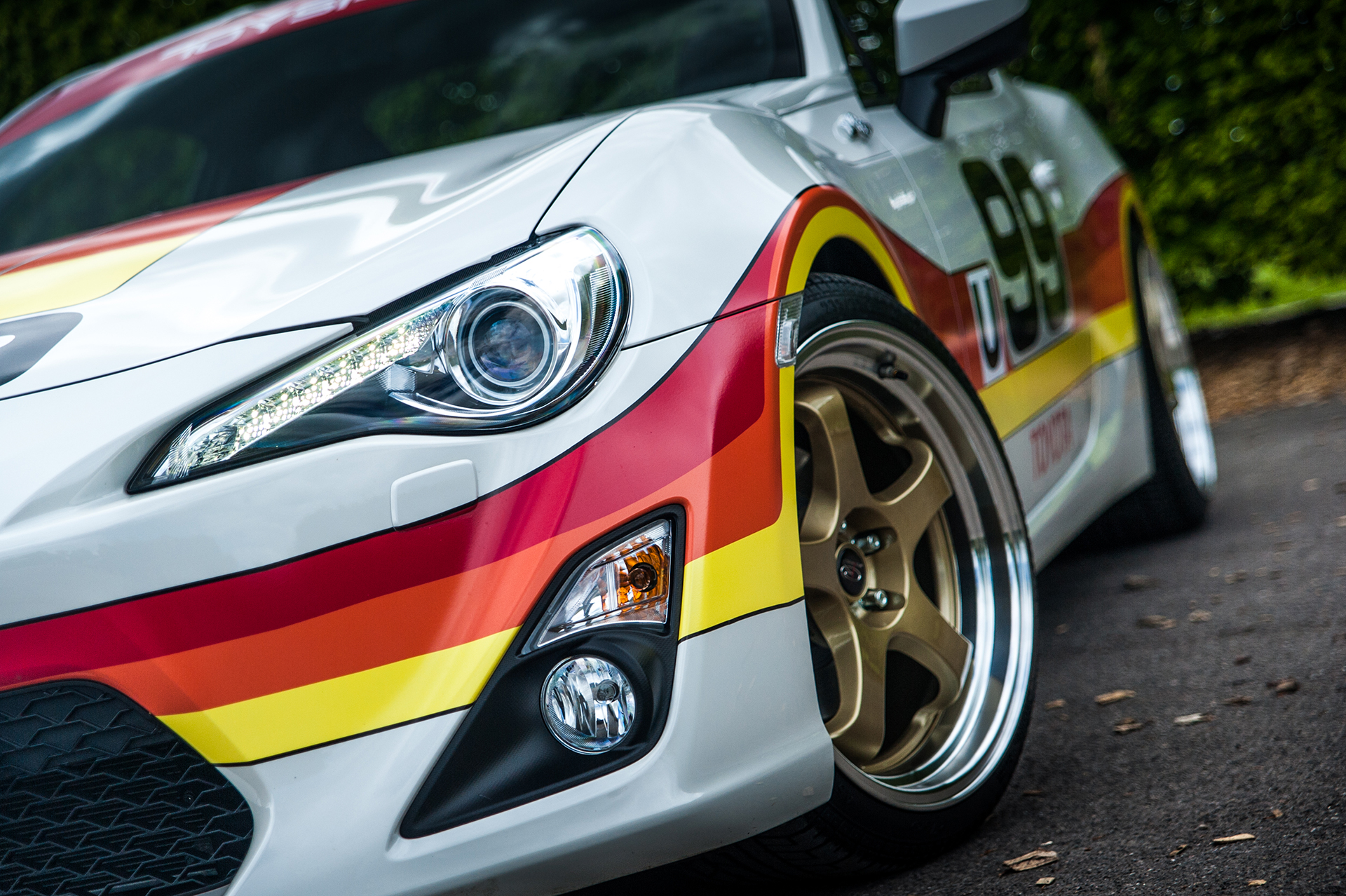
Toyota GT86 – classic livery IMSA GTU class Celica
A key strategy within the worldwide expansion of Toyota’s motorsport activities was the establishment of a second base for the Toyota Racing Developments (TRD) arm in North America.
TRD USA was inaugurated in 1979 and given the power to operate almost autonomously with full engine design, development and assembly facilities that would help it make a more efficient assault on the world stage.
In order to get the ball rolling, two cars based on the third-generation Toyota Celica were prepared by TRD Japan for FIA GT racing and sent to TRD USA. There they were modified to GTU (under 2.5 litres) regulations and tentatively entered in the International Motor Sports Association (IMSA) GT Championship in the latter events of 1981.
Kent Racing took over the programme in 1982 after Toyota Motor Corporation officially lifted the ban on its worldwide motorsport activities. Little success was forthcoming, so TRD USA switched to embark on what would become a very fruitful alliance with Dan Gurney’s All-American Racing (AAR) team for the 1983 season.
Refined under the care of both TRD USA and AAR, the IMSA GTU Celica enjoyed an incredible new lease of life, recording seven pole positions, three fastest laps and two outright wins that year. The following year it continued its performance with four event wins, and then came second in the championship in 1985.
Towards the end of the 1985 race season the Celica’s role altered somewhat as it began a test programme for an upgraded engine that would power the team’s campaign in the higher GTO division the following year. Toyota followed up on this promise by returning to the IMSA GT Championship in 1986, but this time with a car based around the fourth-generation Celica.
Toyota GT86 ‘Celica GT-Four Castrol’ – Goodwood 2015
Toyota Celica GT-Four Castrol, livrée rouge et vert : cette Toyota a fait ses débuts en Championnat du Monde des Rallyes en 1994, catégorie groupe A. Elle enleva sept podiums en sept épreuves lors de la saison 1995, avec comme point d’orgue la victoire de Didier Auriol au Tour de Corse.
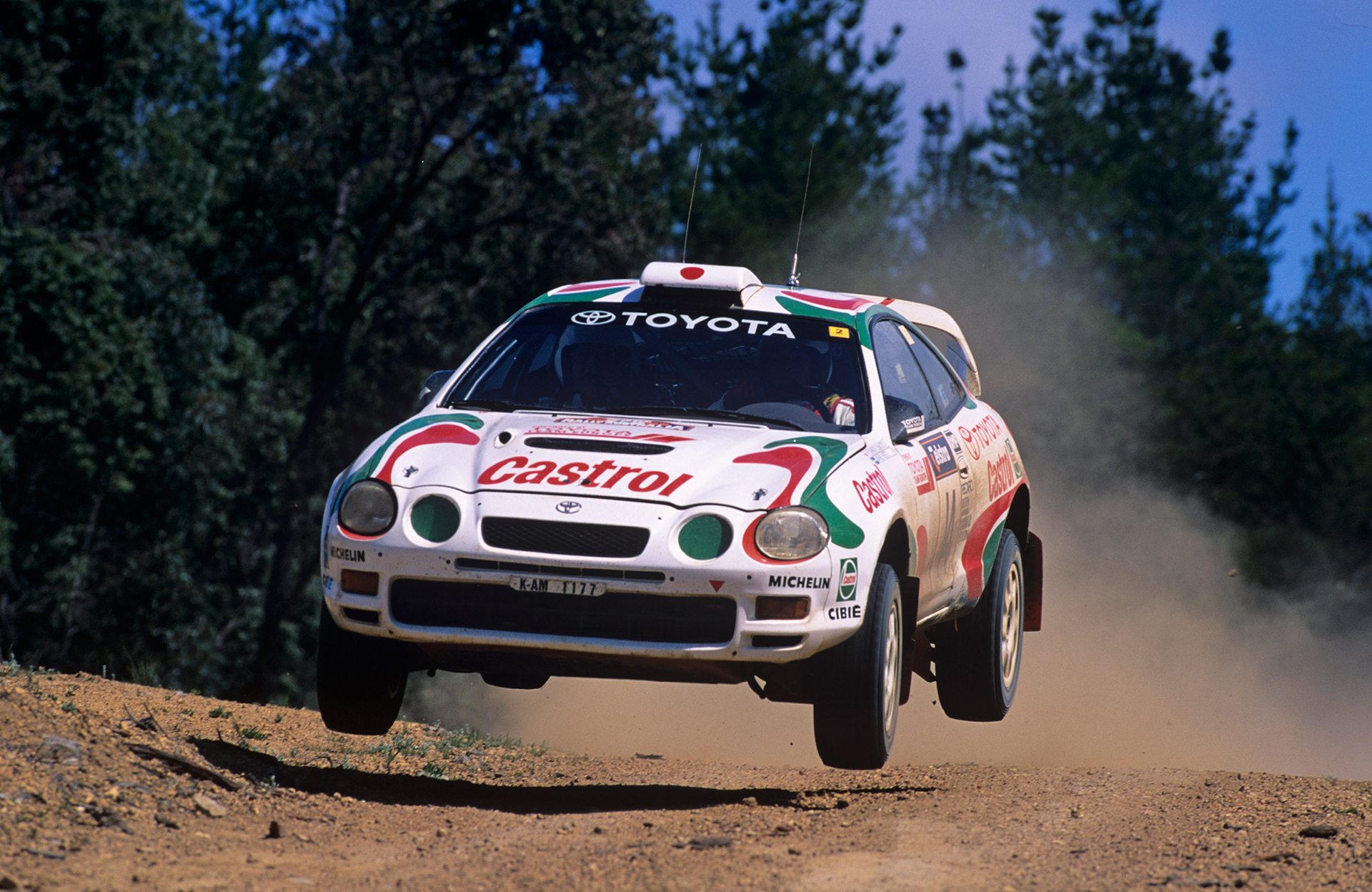
Toyota Castrol Celica GT Four WRC
Toyota GT86 inspired by the Castrol Toyota Celica GT-Four WRC
Castrol Toyota Celica GT-Four (red and green Castrol livery): this Group A Toyota made its World Rally Championship debut in 1994 and went on to claim seven podium finishes in seven events entered during the 1995 season, including victory for Didier Auriol in the Tour de Corse.
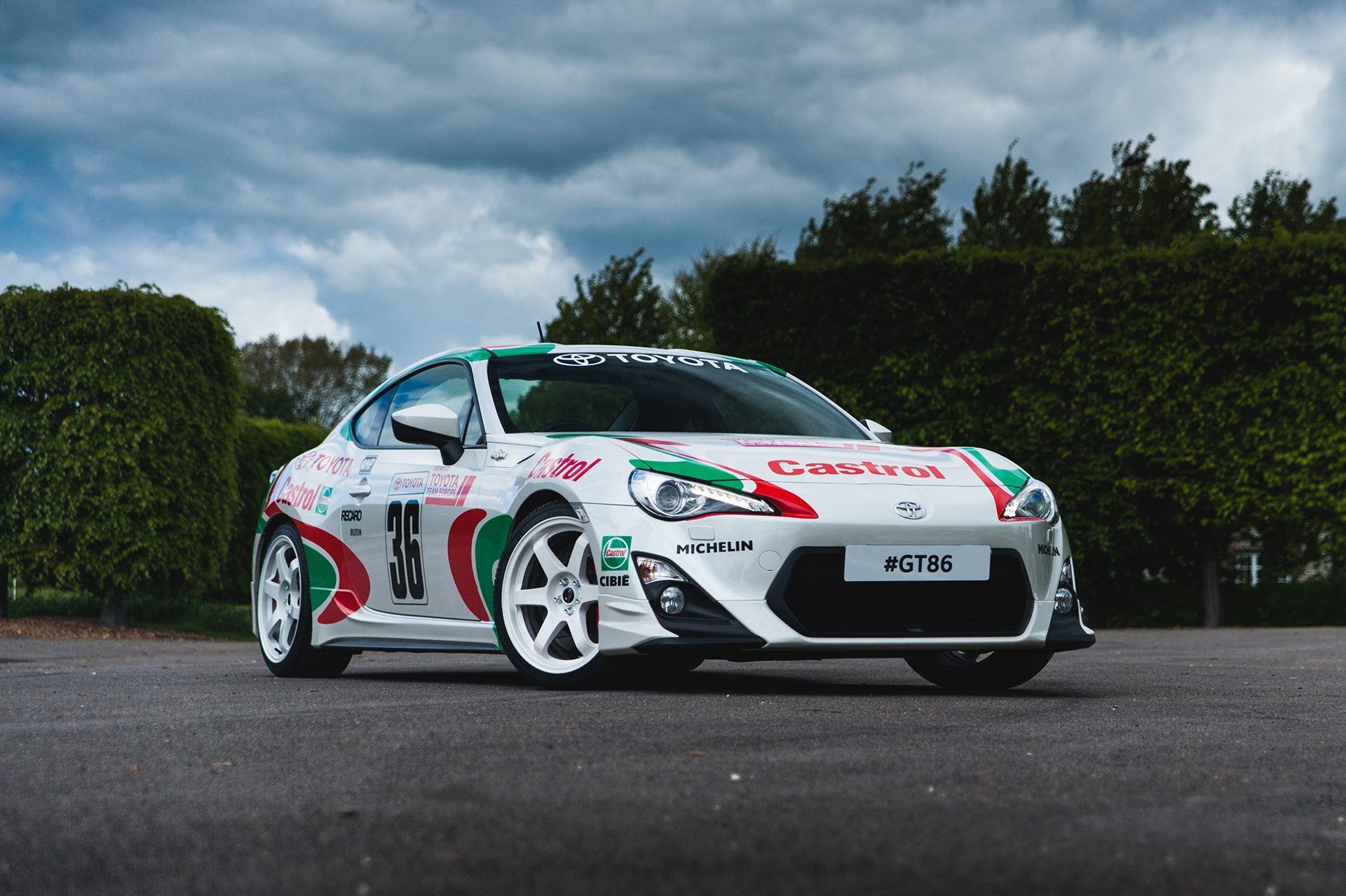
Toyota GT86 – classic livery – Castrol Celica GT Four WRC
The ST205 chassis Castrol Celica GT-Four WRC had perhaps the briefest campaign of all Toyota’s championship competitors. With major sponsorship backing from Castrol, this works GT-Four was built to continue the unprecedented rallying success of the previous ST185 model.
In that respect it was an incredibly high-tech machine that introduced improved aerodynamics, water injection, and clever anti-lag ECU programming to improve turbo performance. Its competition debut in Group A specification was in the 1994 Rally Australia, where Juha Kankkunen set a blistering early pace just nine seconds behind the first-placed car despite some teething issues within the fuelling system.
Juha Kankkunen brought the ST205 to Europe later that year to compete in the Rally Sanremo; and though he failed to get a podium finish, set more fastest stage times than team-mate Didier Auriol in the outgoing ST185 or Carlos Sainz in the rival Subaru.
With all works ST185 models now retired, three Castrol-sponsored ST205 Celica GT-Fours spearheaded Toyota’s WRC campaign in 1995. The team competed in seven rallies that year, highlights of which were seven podium finishes, 13 fastest stage times by Juha Kankkunen in the Rally of Portugal alone, and an overall win for 1994 champion Didier Auriol in the Tour de Corse. The 1996 and 1997 seasons saw no official participation by Toyota in the World Rally Championship. However some works ST205s were still loaned out to private teams competing in the same programme of events and enjoyed good success.
Toyota GT86 ‘Supra Esso Ultron Tiger’ – Goodwood 2015
Toyota Supra Esso Ultron Tiger, livrée pelage Tigre : engagée de longue date au ‘All-Japan Grand Touring Car Championship’, la Supra entre en compétition à partir de 1995 jusqu’à 2006.
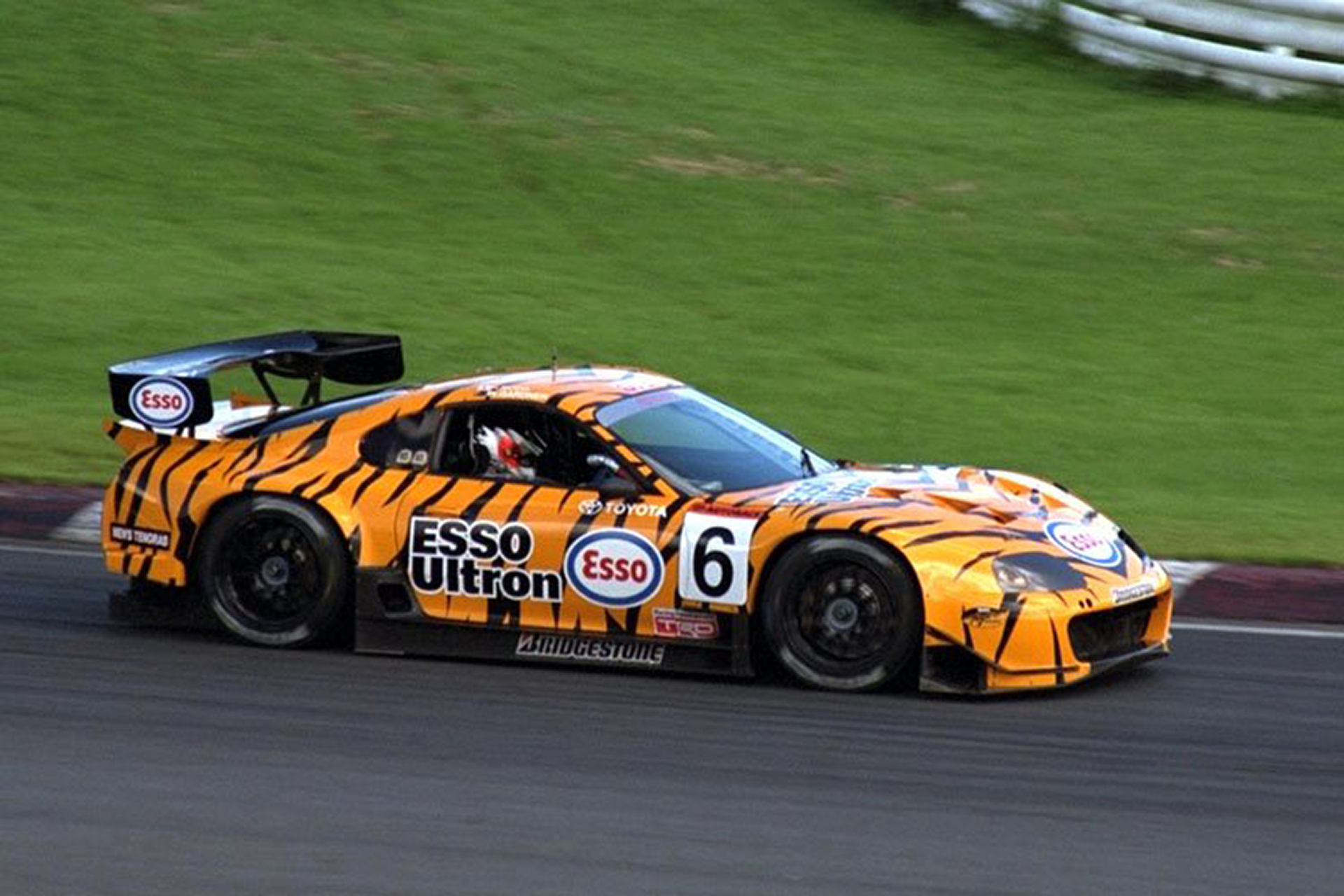
Toyota Esso Ultron Tiger Supra
Toyota GT86 inspired by the Esso Ultron Tiger Toyota Supra
Esso Ultron Tiger Toyota Supra (tigerskin effect): Supra was a longstanding entry in the All-Japan Grand Touring Car Championship, competing from 1995 through to 2006. In fact its competition life went on beyond the end of production of the road-going Supra. When its track days came to an end, it enjoyed a new lease of life as a virtual racer in the Gran Turismo computer game. The Esso Ultron Tiger car was one of the most distinctive-looking to take to the grid.
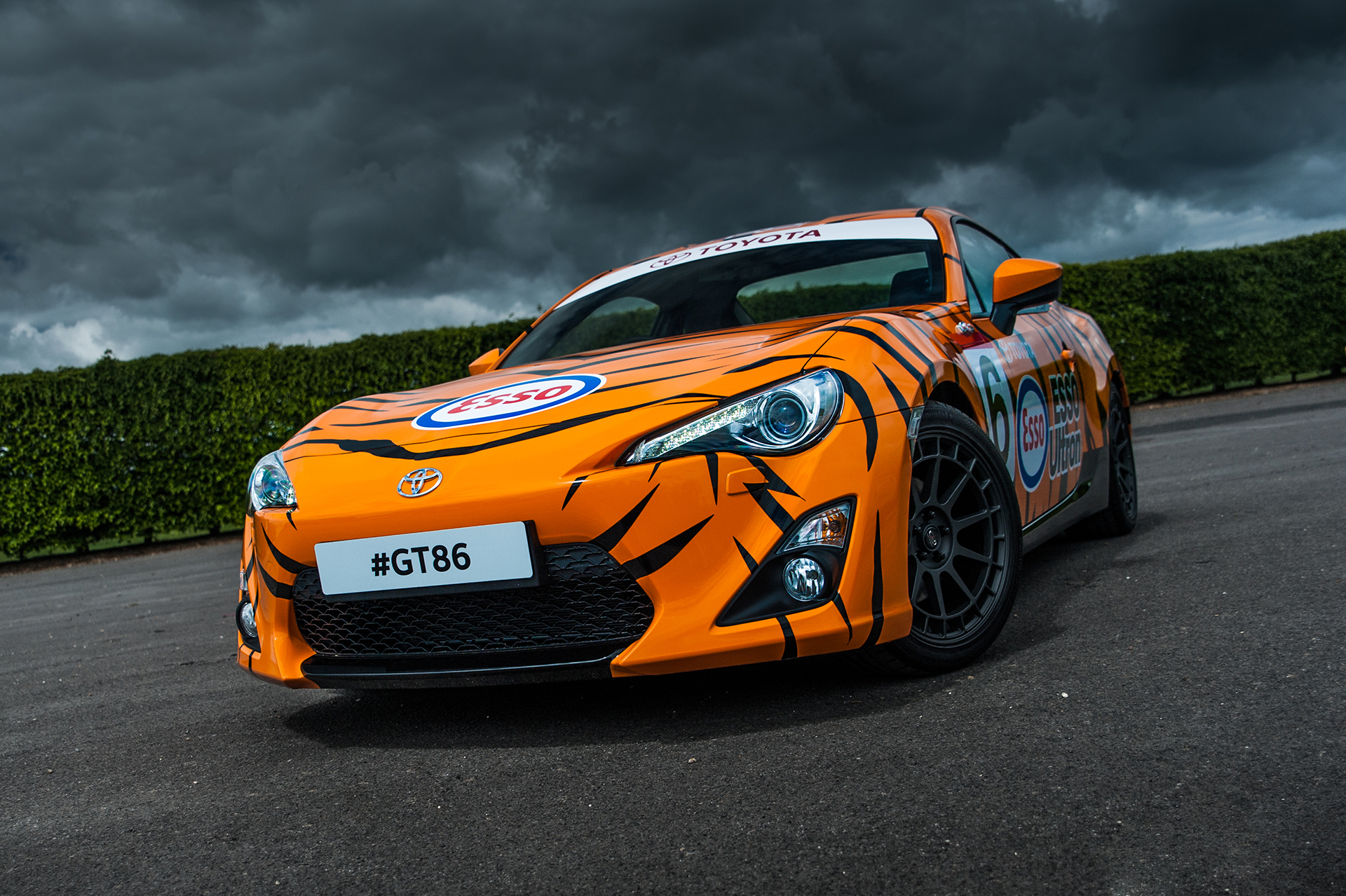
Toyota GT86 – classic livery – Esso Ultron Tiger Supra
The Toyota Supra enjoyed a long campaign in the All-Japan Grand Touring Car Championship (JGTC), beginning in 1995 and extending all the way through to 2006. So successful was the car within this motorsport that it remained in use four years after production of the road car had ceased, and has subsequently enjoyed a new lease of life as one of the most popular racecars in the virtual worlds of Gran Turismo and Forza Motorsport.
The Supra made its inaugural JGTC appearance under GT1 regulations but from the 1996 season onwards the championship was split into GT500 and GT300 classifications, each relating to the maximum allowable output within that category. Powered by a modified version of the four-cylinder 3S-GTE engine used in the Corolla WRC, the GT500 Supra was a force to be reckoned with, taking the title in 1997, 2001, 2002 and 2005.
During the final year of Castrol’s sponsorship of the TOM’S team, another oil company came on board with Team Le Mans and upped the visual ante with one of the most distinctive and predatory race liveries in JGTC history. The graphic took the Running Tiger trademark of the Esso brand and used it as inspiration for a complete makeover to promote the company’s super premium synthetic oil range.
Known as the Esso Ultron Tiger Supra, the model ran during the 1999 and 2000 seasons in the hands of ex-F1 driver Hideki Noda and ex-500cc motorcycle world champion and Australian V8 Supercar driver Wayne Gardner. While the Tiger Supra never reached the same heights as the iconic Castrol Supra, the team showed good form, a highlight being a win and fastest lap for Noda in the fifth round of the 1999 season at Fuji Speedway.
Bonus Photo HD

Toyota GT86 – classic livery – FoS 2015 – face avant / front
Bonus Web
Toyota Racing Development: Timeline TRD USA
Source et images :
Toyota, TRD
… et synthèse de la page Wikipedia :
Toyota GT86 (FR)
… and summary of page Wikipedia:
Toyota 86 (EN)
… and source text via Blog.Toyota.co.uk
Post: Toyota GT86 pays tribute to its heritage with classic liveries (EN)
Post: Making our fleet of retro-tastic Toyota GT86 race replicas (EN)
Partager la publication "Toyota GT86 à l’honneur au Festival of Speed: six classic liveries ハチロク Road to Goodwood 2015"

